
Expert tips for navigating school finances during budget uncertainty
Follow these pro tips to get through challenging financial times
Focus on efficiencies to thrive
When asked to do more with less, pinpoint efficiencies
California Association of School Business Officials Spring 2024
Modern Spaces Inspire Bright Futures.




Whether it’s a single room or an entire campus, a school is more than an educational resource. A school is a community where people thrive. Faculty, administrators and parents team up and rally around a common goal: wholly enrich the lives of their students.
So, when it comes to the facilities that house your school community, be sure to partner with a firm you can trust: Blach Construction. With 50+ years of proven modernization and new construction experience, Blach will empower you to deliver safe, healthy and contemporary spaces that inspire learning, creativity and growth –for each and every student.
Team up with Blach and together, we will build bright futures.
SERVING CALIFORNIA SINCE 1970
Everyone learns, and our most impactful learning experiences are shaped by our environment.
CHERYL JORDAN Superintendent, Milpitas Unified School District
2 California School Business Spring 2024
MEDIA/COLLABORATION SPACE MODERNIZATIONS
LIBRARIES - NEW & UPGRADED FACILITIES 21ST-CENTURY CLASSROOMS & LEARNING CENTER UPGRADES ATHLETIC CENTER IMPROVEMENTS
Area
Central Coast
Southern
Bay
•
•
California
CCL #290418 blachconstruction Learn more at blach.com |
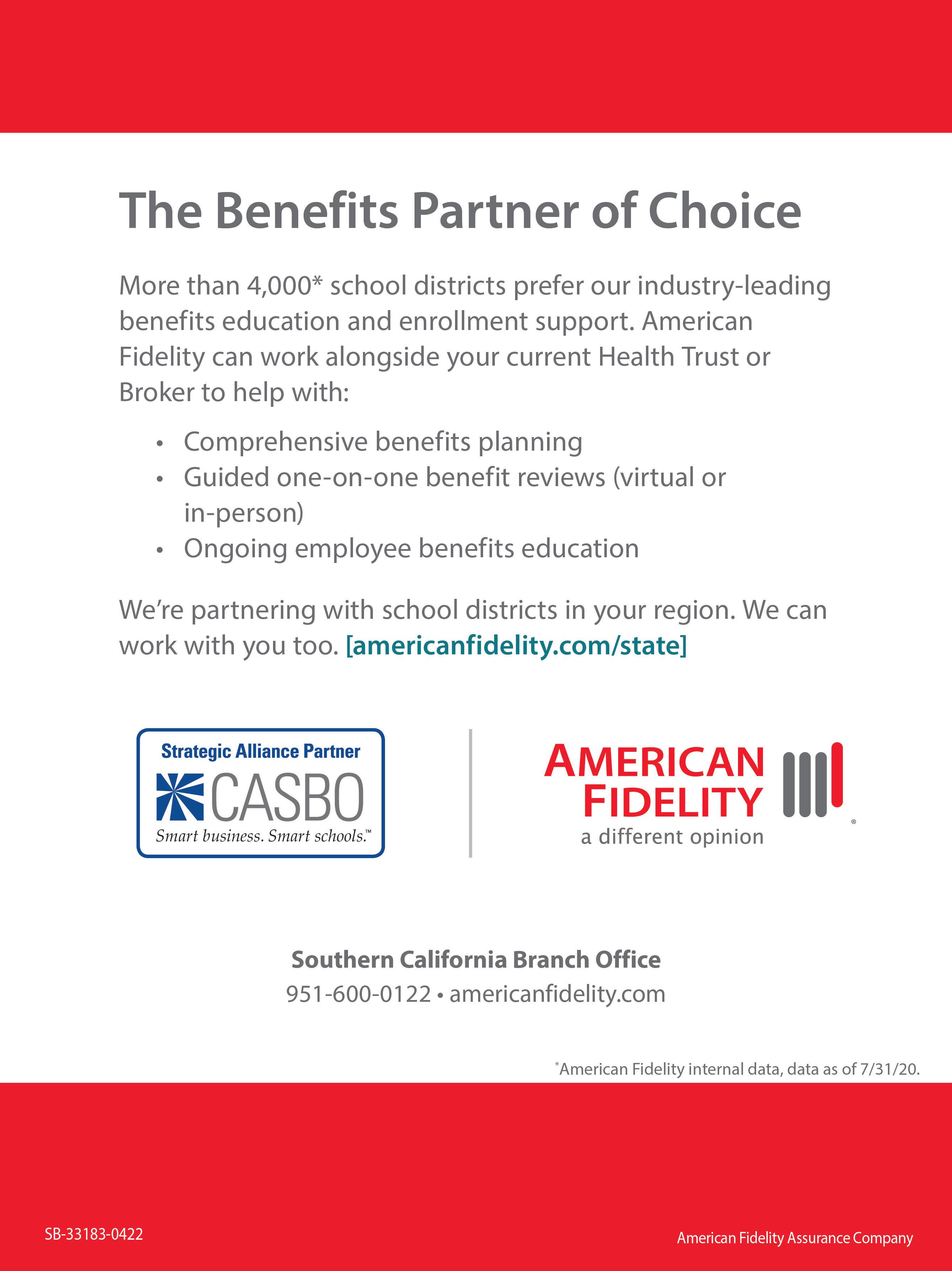
Health insurance is confusing. Let CVT help.

Let’s face it. Dealing with health insurance can be both difficult and at times, downright frustrating. That’s why working with the team that has been making this process easier on its members for more than 35 years makes sense.
Let CVT help you through the confusion. Contact us today!

For more information, visit www.cvtrust.org or call (800) 288-9870




California School Business casbo.org 5 9 CHECKING IN Leading with clarity and resilience Tatia Davenport 11 BOTTOM LINE Thanks to CASBO, you’re never alone Tina Douglas 12 GUEST FEATURE The hard truth about innovative cultures Gary P. Pisano 23 IN FOCUS MEMBER Whitney Hardison 25 IN FOCUS ASSOCIATE MEMBER Terilyn Finders 28 INTERVIEW Kim Scott Author and work culture expert explains Radical Candor’s role in education Julie Phillips Randles 40 COVER FEATURE Expert tips for navigating school finances during budget uncertainty Follow these pro tips to get through challenging financial times Jennifer Snelling 50 FEATURE Focus on efficiencies to thrive When asked to do more with less, pinpoint efficiencies Jennifer Fink Volume 88 Number four Spring 2024 CONTENTS 28 12 50
ABOUT CASBO
The California Association of School Business Officials is the premier resource for professional development in all aspects of school business. Founded in 1928, CASBO serves more than 24,000 members by providing certifications and training, promoting business best practices, and creating opportunities for professional collaboration. CASBO members represent every facet of school business management and operations. The association offers public school leaders an entire career’s worth of growth opportunities.
CASBO MISSION
As the recognized authority in California school business, CASBO is a member-driven association that promotes ethical values; develops exceptional leaders; advocates for, and supports the needs of, members; and sets the standard for excellence through top-quality professional development and mentorship, meaningful collaboration and communication, and unparalleled innovation.
CASBO BY DESIGN
For the past 16 years, CASBO has been dedicated to the organizational planning discipline as a method for guiding the association into a successful future. Last year, the association completed its sixth such plan, CASBO by Design 2.0, a living, breathing document that guided the association in its long-term planning process, which is grassroots in nature, invigorating in procedure and motivating in outcome. Work on our next strategic plan began in 2021.
CASBO has long been committed to organizational planning because the approach has consistently helped the association envision its future and determine the clear steps to get there. The road map that strategic planning provides has allowed CASBO to remain focused on its unique mission, goals and objectives and to respond effectively to a continually changing environment.
For more information on CASBO by Design, visit casbo.org > CASBO + You > About > CASBO By Design.
Stay connected casbo.org
6 California School Business Spring 2024 Publisher Tatia Davenport Features editor Julie Phillips Randles Contributors Jennifer Fink Jennifer Snelling Art director Sharon Adlis Ad production Tracy Brown Advertising sales manager Cici Trino Association Outsource Services, Inc. P.O. Box 39 Fair Oaks, CA 95628 (916) 961-9999 CASBO OFFICERS President Tina Douglas San Dieguito Union High School District
Eric Dill Carlsbad Unified School District
president Aaron Heinz Colusa County Office of Education
past president Diane Deshler Lafayette School District California School Business (ISSN# 1935-0716) is published quarterly by the California Association of School Business Officials, 1001 K Street, 5th Floor, Sacramento, CA 95814, (916) 447-3783. Periodicals postage paid at Sacramento and at additional mailing office. Submit address changes online by logging into your account profile at casbo.org. Articles published in California School Business are edited for style, content and space prior to publication. Views expressed are those of the authors and do not necessarily represent CASBO policies or positions. Endorsement by CASBO of products and services advertised in California School Business is not implied or expressed. Copyright 2024 CASBO. All rights reserved. The contents of the publication may not be reproduced by any means, in whole or in part, without the prior written consent of the publisher. Published March 2024
President-elect
Vice
Immediate
Build RFPs faster
Prequalify for CUPCCAA
Expand your vendor network
Qualify Vendors and promote vendor diversity
Ensure Compliance and Maximize Cost Savings
The only e-system certified by the National Procurement Institute

Visit PlanetBids.com to learn more. with We've simplified procurement to save your team time and resources, enabling you to: Bid faster. Reach

more Vendors.


8 California School Business Spring 2024 CALL 800.462.8328, ext. 4727 EMAIL rpa@schoolsfirstfcu.org


Leading with clarity and resilience
In the midst of challenging economic times, it's imperative that we, as education leaders, navigate with clarity and resilience. This edition of California School Business magazine is dedicated to empowering school business leaders to weather the storm through effective communication and strategic investments in professional development.
We're thrilled to feature an exclusive interview with Kim Scott, the renowned author of Radical Candor, whose insights on fostering open dialogue and cultivating a culture of feedback are more relevant than ever.
As we confront fiscal hurdles, let's remember that investing in your team's growth shouldn’t just be seen as an expense – it's a vital strategy for bolstering knowledge and skills to prevent costly mistakes. Professional development also serves as a clear pathway to success, ensuring that your team is equipped to navigate challenges and seize opportunities with confidence.
Join us as we explore the power of communication, the value of investing in your team and the transformative potential of facing adversity with resilience and innovation – because we really are better together. z z z
Tatia Davenport CEO
California School Business casbo.org 9 CHECKING IN

10 California School Business Spring 2024
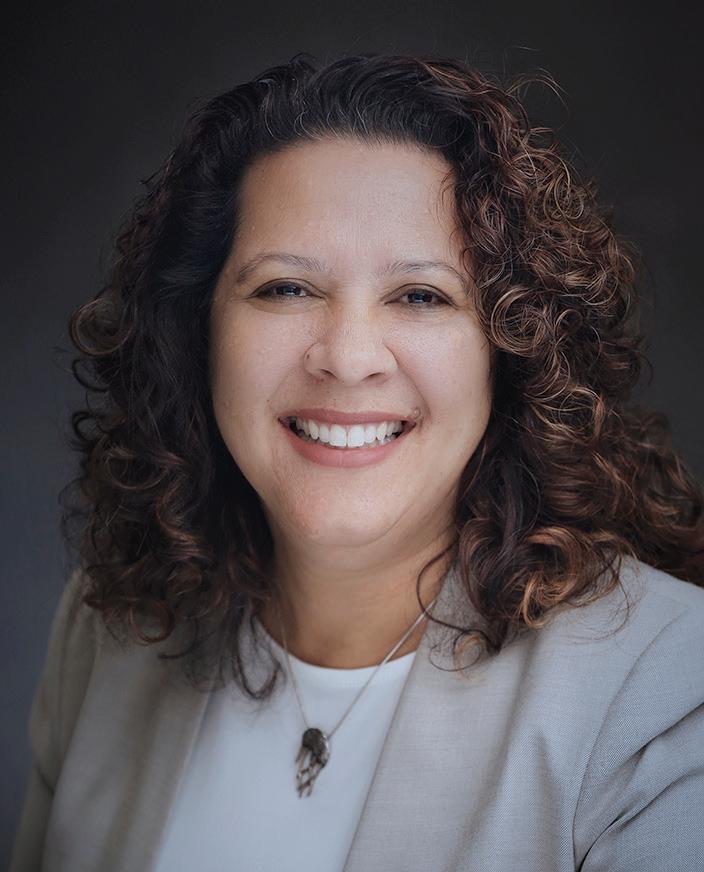
Thanks to CASBO, you’re never alone
You name it, I’m sure I called on someone to help me through it.
After 35 years in school business, I really thought I had seen it all. I endured the implementation of Standardized Account Code Structure, the recession, the transition from revenue limits to the Local Control Funding Formula (LCFF), Super COLA, COLA Zero, the COVID-19 pandemic, flash floods and, most recently, tornado warnings! I was even an interim superintendent for 15 months.
If someone had told my younger self that this is all “a day in the life” of a chief business official (CBO), I never would have believed them!
I don’t recall any of this being covered in my CBO certification program. How could they have been since they were all things school districts had never experienced before. And yet, I and many others in school business managed to lead through these challenges. How, you might ask?
For one, by building my skills as a leader so I could manage a team through crisis. This includes training in communication, crisis management, safety and more. This knowledge helped me face challenges with confidence.
But the main reason I was able to make it through these issues is simple –people. It was the network of professionals in school business – my colleagues, the staff in my district and our business
partners – that helped me through my many years in school business.
I tapped into these people throughout my career for help, to be a thinking partner, to get materials and supplies that were in high demand, to have a shoulder to cry on. You name it, I’m sure I called on someone to help me through it. Not only did I call, but others called me. We called each other. We were never alone.
With the release of the governor’s budget, we’re gearing up for some tough financial years. Remember, you don’t have to go it alone. There are others, like me, who went through the previous recession and can provide guidance. There are many in our field who are very knowledgeable about budgeting, and who are smart and creative.
Tap into the knowledge of those around you. Connect and network through professional development. Now is not the time to slow down learning. You are not alone in your work. All of us at CASBO are here to help! z z z
Tina Douglas President
California School Business casbo.org 11 BOTTOM LINE

The hard truth about innovative cultures
Creativity
can
By Gary P. Pisano
be messy. It needs discipline and management.
A culture conducive to innovation is not only good for a company’s bottom line. It also is something that both leaders and employees value in their organizations. In seminars at companies across the globe, I have informally surveyed hundreds of managers about whether they want to work in an organization where innovative behaviors are the norm. I cannot think of a single instance when someone has said “No, I don’t.” Who can blame them: Innovative cultures are generally depicted as pretty fun. When I asked the same managers to describe such cultures, they readily
provided a list of characteristics identical to those extolled by management books: tolerance for failure, willingness to experiment, psychological safety, highly collaborative and nonhierarchical. And research supports the idea that these behaviors translate into better innovative performance.
But despite the fact that innovative cultures are desirable and that most leaders claim to understand what they entail, they are hard to create and sustain. This is puzzling. How can practices apparently so universally loved – even fun – be so tricky to implement?
The reason, I believe, is that innovative cultures are misunderstood. The easy-to-like behaviors that get so much attention are only one side of the coin. They must be counterbalanced by some tougher and frankly less fun behaviors. A tolerance for failure requires an intolerance for incompetence. A willingness to experiment requires rigorous discipline. Psychological safety requires comfort with brutal candor. Collaboration must be balanced with individual accountability. And flatness requires strong leadership. Innovative cultures are paradoxical. Unless the tensions created
12 California School Business Spring 2024
by this paradox are carefully managed, attempts to create an innovative culture will fail.
1. Tolerance for failure but no tolerance for incompetence
Given that innovation involves the exploration of uncertain and unknown terrain, it is not surprising that a tolerance for failure is an important characteristic of innovative cultures. Some of the most highly touted innovators have had their share of failures. Remember Apple’s MobileMe, Google Glass and the Amazon Fire Phone?
And yet for all their focus on tolerance for failure, innovative organizations are intolerant of incompetence. They set exceptionally high performance standards for their people. They recruit the best talent they can. Exploring risky ideas that ultimately fail is fine, but mediocre technical skills, sloppy thinking, bad work habits and poor management are not. People who don’t meet expectations are either let go or moved into roles that better fit their abilities. Steve Jobs was notorious for firing anyone he deemed not up to the task. At Amazon, employees are ranked on a forced curve, and the bottom part of the distribution is culled. Google is known to have a very employee-friendly culture, but it’s also one of the hardest places on earth to get a job (each year the company gets more than 2 million applications for about 5,000 positions). It, too, has a rigorous performance management system that moves people into new roles if they are not excelling in their existing ones. At Pixar, movie directors who cannot get projects on track are replaced.
It sounds obvious that companies should set high quality standards for their employees, but unfortunately, all too many organizations fall short in this regard. Consider a pharmaceutical company I recently worked with. I learned
that one of its R&D groups had not discovered a new drug candidate in more than a decade. Despite the poor performance, senior leaders had made no real changes in the group’s management or personnel. In fact, under the company’s egalitarian compensation system, the scientists in the group had been receiving approximately the same salaries and bonuses as scientists in much more productive R&D units. One senior leader confided to me that short of ethics violations, the company rarely terminated anyone in R&D for subpar performance. When I asked why, he said, “Our culture is like a family. Firing people is not something we’re comfortable with.”
The truth is that a tolerance for failure requires having extremely competent people. Attempts to create novel technological or business models are fraught with uncertainty. You often don’t know what you don’t know, and you have to learn as you go. “Failures” under these circumstances provide valuable lessons about paths forward. But failure can also result from poorly thought-out designs, flawed analyses, lack of transparency and bad management. Google can encourage risk taking and failure because it can be confident that most Google employees are very competent.
Creating a culture that simultaneously values learning through failure and outstanding performance is difficult in organizations with a history of neither. A good start is for senior leadership to articulate clearly the difference between productive and unproductive failures: Productive failures yield valuable information relative to their cost. A failure should be celebrated only if it results in learning. (The cliché “celebrating failure” misses the point – we should be celebrating learning, not failure.) A simple prototype that fails to perform as expected because of a previously unknown technical issue is a failure worth celebrat-
ing if that new knowledge can be applied to future designs. Launching a badly engineered product after spending $500 million developing it is just an expensive flop.
Building a culture of competence requires clearly articulating expected standards of performance. If such standards are not well understood, difficult personnel decisions can seem capricious or, worse, be misconstrued as punishment for a failure. Senior leaders and managers throughout the organization should communicate expectations clearly and regularly. Hiring standards may need to be raised, even if that temporarily slows the growth of the company.
Managers are especially uncomfortable about firing or moving people when their “incompetence” is no fault of their own. Shifting technologies or business models can render a person who’s very competent in one context incompetent in another. Consider how digitization has impacted the value of different skills in many industries. That sales representative whose deft interpersonal skills made him a superstar may no longer be as valuable to the organization as the introverted software engineer who develops the algorithms used to predict which customers are most likely to buy the company’s products. In some cases, people can be retrained to develop new competences. But that’s not always possible when really specialized skills (say, a Ph.D. in applied math) are needed to do a job. Keeping people who have been rendered obsolete may be compassionate, but it’s dangerous for the organization.
Maintaining a healthy balance between tolerating productive failures and rooting out incompetence is not easy. A 2015 New York Times article about Amazon illustrates the difficulty. The piece, which was based on interviews with more than 100 current and former employees, labeled Amazon’s culture
California School Business casbo.org 13 GUEST FEATURE
The hard truth about innovative cultures
as “bruising” and recounted stories of employees crying at their desks amid enormous performance pressures. One reason striking a balance is so hard is that the causes of failure are not always clear. Did a product design turn out to be flawed because of an engineer’s bad judgment or because it encountered a problem that even the most talented engineer would have missed? And in the event of bad technical or business judgments, what are the appropriate consequences? Everyone makes mistakes, but at what point does forgiveness slide into permissiveness? And at what point does setting high performance standards devolve into being cruel or failing to treat employees – regardless of their performance – with respect and dignity?
2. Willingness to experiment but highly disciplined
Organizations that embrace experimentation are comfortable with uncertainty and ambiguity. They do not pretend to know all the answers up front or to be able to analyze their way to insight. They experiment to learn rather than to produce an immediately marketable product or service.
A willingness to experiment, though, does not mean working like some third-rate abstract painter who randomly throws paint at a canvas. Without discipline, almost anything can be justified as an experiment. Disciplineoriented cultures select experiments carefully on the basis of their potential learning value, and they design them rigorously to yield as much information as possible relative to the costs. They establish clear criteria at the outset for deciding whether to move forward with, modify or kill an idea. And they face the facts generated by experiments. This may mean admitting that an initial hypothesis was wrong and that a project that once
seemed promising must be killed or significantly redirected. Being more disciplined about killing losing projects makes it less risky to try new things.
A good example of a culture that combines a willingness to experiment with strict discipline is Flagship Pioneering, a Cambridge, Massachusetts, company whose business model is creating new ventures based on pioneering science. Flagship generally does not solicit business plans from independent entrepreneurs but instead uses internal teams of scientists to discover newventure opportunities. The company has a formal exploration process whereby small teams of scientists, under the direction of one of the company’s partners, undertake research on a problem of major social or economic importance – nutrition, for example. During these explorations, teams read the literature on the topic and engage the company’s broad network of external scientific advisers to conceive new scientific insights. Explorations are initially unconstrained. All ideas – however seemingly unreasonable or far-fetched – are entertained. According to founder and CEO Noubar Afeyan, “Early in our explorations, we don’t ask, ‘Is this true?’ or ‘Is there data to support this idea?’ We do not look for academic papers that provide proof that something is true. Instead, we ask ourselves, ‘What if this were true?’ or ‘If only this were true, would it be valuable?’” Out of this process, teams are expected to formulate testable venture hypotheses.
Experimentation is central to Flagship’s exploration process because it is how ideas are culled, reformulated and evolved. But experimentation at Flagship differs in fundamental ways from what I often see at other companies. First, Flagship does not run experiments to validate initial ideas. Instead, teams are expected to design “killer experiments” that maximize the probability of expos-
ing an idea’s flaws. Second, unlike many established companies that heavily fund new ventures in the mistaken belief that more resources translate into more speed and more creativity, Flagship normally designs its killer experiments to cost less than $1 million and take less than six months. Such a lean approach to testing not only enables the firm to cycle through more ideas more quickly, it also makes it psychologically easier to walk away from projects that are going nowhere. It forces teams to focus narrowly on the most critical technical uncertainties and gives them faster feedback. The philosophy is to learn what you have gotten wrong early and then move quickly in morepromising directions.
Third, experimental data at Flagship is sacred. If an experiment yields negative data about a hypothesis, teams are expected to either kill or reformulate their ideas accordingly. In many organizations, getting an unexpected result is “bad news.” Teams often feel the need to spin the data – describing the result as an aberration of some sort – to keep their programs alive. At Flagship, ignoring experimental data is unacceptable.
Finally, Flagship’s venture team members themselves have a strong incentive to be disciplined about their programs. They gain no financial benefit from sticking with a loser program. In fact, just the opposite is true. Continuing to pursue a failed program means forgoing the opportunity to join a winning one. Again, compare this model with what is common in many companies: Having your program canceled is terrible news for you personally. It could mean loss of status or perhaps even your job. Keeping your program alive is good for your career. At Flagship, starting a successful venture, not keeping your program alive, is good for your career. (Disclosure: I serve on the board of a Flagship company, but the information in this example
14 California School Business Spring 2024

Choose a Partner Who Knows California Education Finance
Piper Sandler is a leader in providing financial services to California public schools. We are committed to providing access for communities to participate in their local bond offerings. We guide school districts across the state on the construction and modernization of school facilities, solar equipment projects, school site acquisitions and upgrading of technology equipment. Our team assists school districts on navigating the complex general obligation bond process from start to finish.
General Obligation Bonds | Certificates of Participation | Mello-Roos/CFD Bonds Interim Project Financing | Debt Refinancing/Restructuring | Tax & Revenue Anticipation Notes
Rich Calabro
MANAGING DIRECTOR +1 310 297-6013
richard.calabro@psc.com
Halina De La Rosa
ASSOCIATE +1 310-297-6033
halina.delarosa@psc.com
Jin Kim MANAGING DIRECTOR +1 310 297-6020
jin.kim@psc.com
Celina Zhao
ASSOCIATE +1 310 297-6019
celina.zhao@psc.com
Ivory Li
MANAGING DIRECTOR
+1 415 616-1614
ivory.li@psc.com
Mark Adler
MANAGING DIRECTOR +1 310 297-6010
mark.adler@psc.com
Christen Gair
MANAGING DIRECTOR
+1 310 297-6018
christen.gair@psc.com
Pam Morris-Hammer
OFFICE SUPERVISOR
+1 310 297-6023
pamela.hammer@psc.com

California School Business casbo.org 15
Since 1895. Member SIPC and NYSE. © 2024 Piper Sandler & Co. CM-24-0375 2/24
Visit us at pipersandler.com/CAeducationfinance
The hard truth about innovative cultures
comes from a Harvard Business School case I researched and co-authored.)
Disciplined experimentation is a balancing act. As a leader, you want to encourage people to entertain “unreasonable ideas” and give them time to formulate their hypotheses. Demanding data to confirm or kill a hypothesis too quickly can squash the intellectual play that is necessary for creativity. Of course, not even the best-designed and well-executed experiments always yield black-and-white results. Scientific and business judgments are required to figure out which ideas to move forward, which to reformulate and which to kill. But senior leaders need to model discipline by, for example, terminating projects they personally championed or demonstrating a willingness to change their minds in the face of the data from an experiment.
3. Psychologically safe but brutally candid
Psychological safety is an organizational climate in which individuals feel they can speak truthfully and openly about problems without fear of reprisal. Decades of research on this concept by Harvard Business School professor Amy Edmondson indicate that psychologically safe environments not only help organizations avoid catastrophic errors but also support learning and innovation. For instance, when Edmondson, health care expert Richard Bohmer and I conducted research on the adoption of a novel minimally invasive surgical technology by cardiac surgical teams, we found that teams with nurses who felt safe speaking up about problems mastered the new technology faster. If people are afraid to criticize, openly challenge superiors’ views, debate the ideas of others and raise counter perspectives, innovation can be crushed.
We all love the freedom to speak our minds without fear – we all want to be heard – but psychological safety is a twoway street. If it is safe for me to criticize your ideas, it must also be safe for you to criticize mine – whether you’re higher or lower in the organization than I am. Unvarnished candor is critical to innovation because it is the means by which ideas evolve and improve. Having observed or participated in numerous R&D project team meetings, project review sessions, and board of directors’ meetings, I can attest that comfort with candor varies dramatically. In some organizations, people are very comfortable confronting one another about their ideas, methods and results. Criticism is sharp. People are expected to be able to defend their proposals with data or logic.
In other places, the climate is more polite. Disagreements are restrained. Words are carefully parsed. Critiques are muffled (at least in the open). To challenge too strongly is to risk looking like you’re not a team player. One manager at a large company where I worked as a consultant captured the essence of the culture when she said, “Our problem is that we are an incredibly nice organization.”
When it comes to innovation, the candid organization will outperform the nice one every time. The latter confuses politeness and niceness with respect. There is nothing inconsistent about being frank and respectful. In fact, I would argue that providing and accepting frank criticism is one of the hallmarks of respect. Accepting a devastating critique of your idea is possible only if you respect the opinion of the person providing that feedback.
Still, that important caveat aside, “brutally honest” organizations are not necessarily the most comfortable environments in which to work. To outsiders and newcomers, the people may appear
aggressive or hard-edged. No one minces words about design philosophies, strategy, assumptions or perceptions of the market. Everything anyone says is scrutinized (regardless of the person’s title).
Building a culture of candid debate is challenging in organizations where people tend to shy away from confrontation or where such debate is viewed as violating norms of civility. Senior leaders need to set the tone through their own behavior. They must be willing (and able) to constructively critique others’ ideas without being abrasive. One way to encourage this type of culture is for them to demand criticism of their own ideas and proposals. A good blueprint for this can be found in General Dwight D. Eisenhower’s battle-plan briefing to top officers of the Allied forces three weeks before the invasion of Normandy. As recounted in Eisenhower, a biography by Geoffrey Perret, the general started the meeting by saying, “I consider it the duty of anyone who sees a flaw in this plan not to hesitate to say so. I have no sympathy with anyone, whatever his station, who will not brook criticism. We are here to get the best possible results.”
Eisenhower was not just inviting criticism or asking for input. He was literally demanding it and invoking another sacred aspect of military culture: duty. How often do you demand criticism of your ideas from your direct reports?
4. Collaboration but with individual accountability
Well-functioning innovation systems need information, input and significant integration of effort from a diverse array of contributors. People who work in a collaborative culture view seeking help from colleagues as natural, regardless of whether providing such help is within their colleagues’ formal
16 California School Business Spring 2024


Service is at the heart of who we are
It’s our highest aspiration
Over 470 California public school districts have joined together to make SISC what it is today.
We have a 44 year history of providing our members with coverage for workers’ compensation, property and liability and health benefits.
Districts join SISC for our consistently low rates, but they will tell you our service is the reason they stay for decades.
We’d love to serve you, too.


California School Business casbo.org 17
A Joint Powers Authority administered by the Kern County Superintendent of Schools Office, John G Mendiburu, Superintendent Interested in membership? Let’s talk. Call us at (800) 972-1727 or visit www.sisc.kern.org
The hard truth about innovative cultures
job descriptions. They have a sense of collective responsibility.
But too often, collaboration gets confused with consensus. And consensus is poison for rapid decision-making and navigating the complex problems associated with transformational innovation. Ultimately, someone has to make a decision and be accountable for it. An accountability culture is one where individuals are expected to make decisions and own the consequences.
There is nothing inherently inconsistent about a culture that is both collaborative and accountability focused. Committees might review decisions or teams might provide input, but at the end of the day, specific individuals are charged with making critical design choices – deciding which features go and stay, which suppliers to use, which channel strategy makes most sense, which marketing plan is best and so on. Pixar has created several ways to provide feedback to its movie directors, but as Ed Catmull, its co-founder and president, describes in his book Creativity, Inc., the director chooses which feedback to take and which to ignore, and is held accountable for the contents of the movie.
Accountability and collaboration can be complementary, and accountability can drive collaboration. Consider an organization where you personally will be held accountable for specific decisions. There is no hiding. You own the decisions you make, for better or worse. The last thing you would do is shut yourself off from feedback or from enlisting the cooperation and collaboration of people inside and outside the organization who can help you.
A good example of how accountability can drive collaborative behavior is Amazon. In researching a case for Harvard Business School, I learned that when Andy Jassy became head of Amazon’s then-fledgling cloud computer business
in 2003, his biggest challenge was figuring out what services to build (hardly an easy task given that cloud services were a completely new space for Amazon – and the world). Jassy immediately sought help from Amazon’s technology teams, its business and technical leaders, and external developers. Their feedback about requirements, problems and needs was critical to the early success of what eventually became Amazon Web Services – today a profitable $12 billion business run by Jassy. For Jassy, collaboration was essential to the success of a program for which he was personally accountable.
Leaders can encourage accountability by publicly holding themselves accountable, even when that creates personal risks. Some years ago, when Paul Stoffels headed R&D at Johnson & Johnson’s pharmaceutical division, his group experienced a failure in a major late-stage clinical program. (Disclosure: I have consulted for various divisions of Johnson & Johnson.) As Stoffels recounted at a meeting of J&J managers that I attended, senior leadership and the board demanded to know who was at fault when the program had its setback. “I am accountable,” Stoffels replied. “If I let this go beyond me, and I point to people who took the risk to start and manage the program, then we create a risk-averse organization and are worse off. This stops with me.” Stoffels, now chief scientific officer for J&J, shares this story frequently with employees throughout the corporation. He finishes with a simple promise: “You take the risk; I will take the blame.” And then he urges his audience to cascade this principle down the organization.
5. Flat but strong leadership
An organizational chart gives you a pretty good idea of the structural flatness of a company but reveals little about its cultural flatness – how people
behave and interact regardless of official position. In culturally flat organizations, people are given wide latitude to take actions, make decisions and voice their opinions. Deference is granted on the basis of competence, not title. Culturally flat organizations can typically respond more quickly to rapidly changing circumstances because decision-making is decentralized and closer to the sources of relevant information. They tend to generate a richer diversity of ideas than hierarchical ones, because they tap the knowledge, expertise and perspectives of a broader community of contributors.
Lack of hierarchy, though, does not mean lack of leadership. Paradoxically, flat organizations require stronger leadership than hierarchical ones. Flat organizations often devolve into chaos when leadership fails to set clear strategic priorities and directions. Amazon and Google are very flat organizations in which decision-making and accountability are pushed down and employees at all levels enjoy a high degree of autonomy to pursue innovative ideas. Yet both companies have incredibly strong and visionary leaders who communicate goals and articulate key principles about how their respective organizations should operate.
Here again, the balance between flatness and strong leadership requires a deft hand by management. Flatness does not mean that senior leaders distance themselves from operational details or projects. In fact, flatness allows leaders to be closer to the action. The late Sergio Marchionne, who led the resurrection of first Fiat and then Chrysler (and was the architect of their merger) commented to me during an interview for a Harvard Business School case I wrote: “At both companies, I used the same core principles for the turnaround. First, I flattened the organization. I had to reduce the distance between me and the people making decisions. [At one point, Marchionne had
18 California School Business Spring 2024
46 direct reports between the two organizations.] If there is a problem, I want to know directly from the person involved, not their boss.”
At both Fiat and Chrysler, Marchionne moved his office to the engineering floor so that he could be closer to product planning and development programs. He was famous both for being detail oriented and for pushing decision-making down to lower levels in the organization. (With so many direct reports, it was nearly impossible for him not to!)
Getting the balance right between flatness and strong leadership is hard on top management and on employees throughout the organization. For senior leaders, it requires the capacity to articulate compelling visions and strategies
(big-picture stuff), while simultaneously being adept and competent with technical and operational issues. Steve Jobs was a great example of a leader with this capacity. He laid out strong visions for Apple, while being maniacally focused on technical and design issues. For employees, flatness requires them to develop their own strong leadership capacities and be comfortable with taking action and being accountable for their decisions.
Leading the journey
All cultural changes are difficult. Organizational cultures are like social contracts specifying the rules of membership. When leaders set out to change the culture of an organization, they are in a sense breaking a social
contract. It should not be surprising, then, that many people inside an organization – particularly those thriving under the existing rules – resist.
Leading the journey of building and sustaining an innovative culture is particularly difficult for three reasons. First, because innovative cultures require a combination of seemingly contradictory behaviors, they risk creating confusion. A major project fails. Should we celebrate? Should the leader of that program be held accountable? The answer to these questions depends on the circumstances. Was the failure preventable? Were issues known in advance that could have led to different choices? Were team members transparent? Was there valuable learning from the experience? And so on. Without clarity around these nuances, people

HELPING SCHOOLS MAXIMIZE FEDERAL GRANTS
California School Business casbo.org 19
The hard truth about innovative cultures
can easily get confused and even cynical about leadership’s intentions.
Second, while certain behaviors required for innovative cultures are relatively easy to embrace, others will be less palatable for some in the organization. Those who think of innovation as a free-for-all will see discipline as an unnecessary constraint on their creativity; those who take comfort in the anonymity of consensus won’t welcome a shift toward personal accountability. Some people will adapt readily to the new rules – a few may even surprise you – but others will not thrive.
Third, because innovative cultures are systems of interdependent behaviors, they cannot be implemented in a piecemeal fashion. Think about how the behaviors complement and reinforce one another. Highly competent people will be more comfortable with decisionmaking and accountability – and their “failures” are likely to yield learning rather than waste. Disciplined experimentation will cost less and yield more useful information – so, again, tolerance for failed experiments becomes prudent rather than shortsighted. Accountability makes it much easier to be flat – and flat organizations create a rapid flow of information, which leads to faster, smarter decision-making.
Beyond the usual things that leaders can do to drive cultural change (articulate and communicate values, model target behaviors and so on), building an innovative culture requires some specific actions. First, leaders must be very transparent with the organization about the harder realities of innovative cultures. These cultures are not all fun and games. Many people will be excited about the prospects of having more freedom to experiment, fail, collaborate, speak up and make decisions. But they also have to recognize that with these freedoms come some tough responsibilities. It’s better to
be upfront from the outset than to risk fomenting cynicism later when the rules appear to change midstream.
Second, leaders must recognize that there are no shortcuts in building an innovative culture. Too many leaders think that by breaking the organization into smaller units or creating autonomous “skunk works” they can emulate an innovative startup culture. This approach rarely works. It confuses scale with culture. Simply breaking a big bureaucratic organization into smaller units does not magically endow them with entrepreneurial spirit. Without strong management efforts to shape values, norms and behaviors, these offspring units tend to inherit the culture of the parent organization that spawned them. This does not mean that autonomous units or teams can’t be used to experiment with a culture or to incubate a new one. They can. But the challenge of building innovative cultures inside these units should not be underestimated. And they will not be for everyone, so you will need to select very carefully who from the parent organization joins them.
Finally, because innovative cultures can be unstable, and tension between the counterbalancing forces can easily be thrown out of whack, leaders need to be vigilant for signs of excess in any area and intervene to restore balance when necessary. Unbridled, a tolerance for failure can encourage slack thinking and excuse making, but too much intolerance for incompetence can create fear of risk taking. Neither of these extremes is helpful. If taken too far, a willingness to experiment can become permission to take poorly conceived risks, and overly strict discipline can squash good but illformed ideas. Collaboration taken too far can bog down decision-making, but excessive emphasis on individual accountability can lead to a dysfunctional climate in which everyone jealously
protects his or her own interests. There is a difference between being candid and just plain nasty. Leaders need to be on the lookout for excessive tendencies, particularly in themselves. If you want your organization to strike the delicate balance required, then you as a leader must demonstrate the ability to strike that balance yourself. z z z
Gary P. Pisano is the Harry E. Figgie Jr. Professor of Business Administration at Harvard Business School and the author of Creative Construction: The DNA of Sustained Innovation (PublicAffairs, 2019).
A version of this article appeared in the January-February 2019 issue (pp.62–71) of Harvard Business Review. Reprinted with permission.
© 2019 Harvard Business School Publishing Corp.
20 California School Business Spring 2024
Saving the day with technology. Equipping a district to succeed.
When a school district’s plan to secure new Chromebooks with federal funding for its K–12 students was nearly derailed by microchip shortages, ODP Business Solutions delivered.

The school district was set to purchase $6.5 million of new Chromebooks for students in 2021; however, 2020’s global manufacturing strain caused a shortage in microchips that the original equipment manufacturer (OEM) needed to build the Chromebooks. This disruption meant the OEM would miss the district’s deadline, leaving nearly 15,000 students and teachers without vital technology.

ODP Business Solutions
888.263.3423
odpbusiness.com/education

Fortunately, ODP Business Solutions already had a solid relationship with the school district, and the teams agreed that keeping the current timeline and working with a new supplier was the best option.
Leveraging its industry experience and connections with other OEMs, ODP Business Solutions quickly found another supplier that had the technology available and could meet the timeline. Once the Chromebooks were delivered, ODP Business Solutions connected with a local Disabled Veteran Business Enterprise (DVBE) to provision each device and rewire 401 carts at the district’s schools to enable charging and safekeeping.
The project was bigger than the delivery of Chromebooks: Its success meant that students and teachers could return to school with the technology they expected.
We may be new to you, but educators are not new to us.
Horace Mann is a long-time CASBO corporate supporter, and we’re dedicated to supporting you and your educators with:
• auto and home insurance that comes with special benefits and discounts for educators;
• life insurance with preferred rates for educators; and
• retirement solutions to help you plan for what life looks like outside of the classroom one day.
And if your employees struggle with things like student loan debt, finding classroom funding or becoming more financially secure, we have programs and workshops to help with that, too.
Sound like something worth exploring? Our knowledgeable, friendly representatives are standing by ready to answer your questions.
To learn more or get a quote, visit horacemann .com

Horace Mann Insurance Company and its affiliates underwrite Horace Mann auto and home insurance. Not all discounts and benefits available in all states. Horace Mann Life Insurance Company underwrites Horace Mann life insurance products. Horace Mann Service Corporation and certain of its affiliates (Horace Mann) enter into agreements with educational associations where Horace Mann pays the association to familiarize association members with the Horace Mann brand, products or services. Contact association.relations@horacemann.com for more information.
AM-C04767 (Oct. 23)
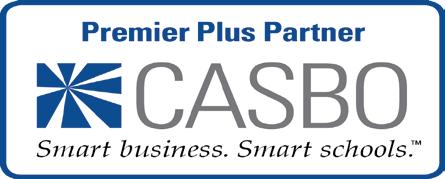
California School Business casbo.org 21
ofd3559 01.23 ODP and ODP Business Solutions are trademarks of ODP Business Solutions, LLC. © 2023 ODP Business Solutions, LLC. All rights reserved.


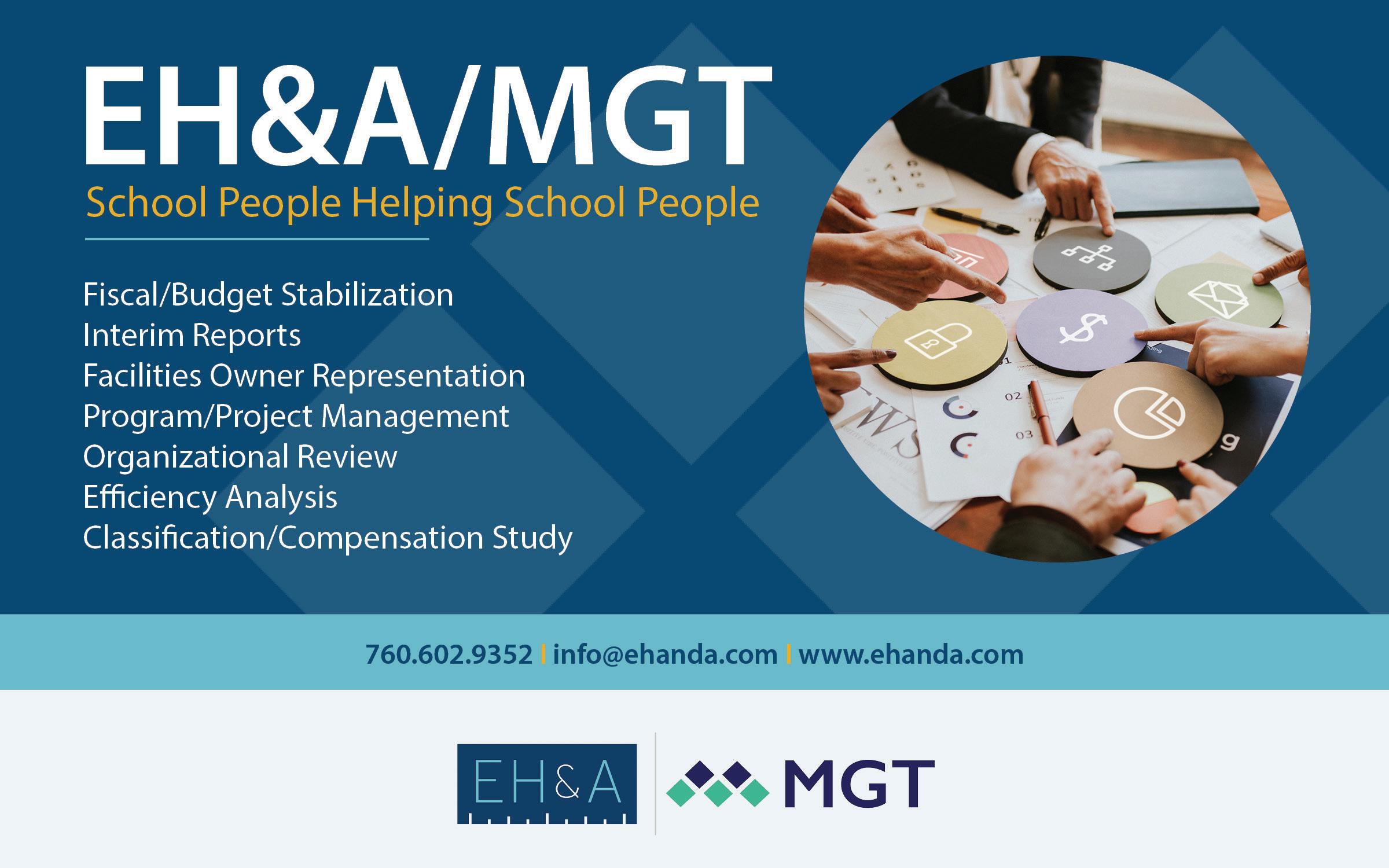
22 California School Business Spring 2024 BUSINESS OFFICE TOOLS TO STREAMLINE YOUR BOND, FINANCIAL TRACKING, & PROCUREMENT Jon Patterson Director of Sales and Marketing JPatterson@ColbiTech.com (714) 505-9544 ColbiTech.com QualityBidders SM Contractor Prequalification Solutions SecureBids SM Online Controlled Bidding and Other Submissions COLBIDocs SM Construction Document Processing and Storage SM K-12 Bond Program Management Software
Whitney Hardison
She takes servant leadership to a whole new level
By Julie Phillips Randles

WHILE THE CONCEPT OF SERVANT LEADERSHIP has been around since the 1970s, for Whitney Hardison, external business services coordinator for the Sutter County Superintendent of Schools (SCSOS), it’s a multigenerational family tradition.
Hardison has been serving students and her community through the school business profession for a dozen years. And her family provided many examples of what it means to meet others where they are. Her grandmother was a social worker, her father was a U.S. Navy veteran, her mother is a retired law enforcement officer and her husband is also a law enforcement officer.
“I was raised to have a servant’s heart, and I love giving back to the profession and to my community. People have mentored me, and I believe that energy feeds energy,” Hardison says.
In her current role, Hardison provides fiscal oversight for Sutter County’s K-12 schools’ budgets. That means identifying any fiscal issues coming down the road before schools get into financial trouble, and ensuring that taxpayer dollars are well spent. Her department also provides direct accounting and fiscal services for the small districts in the county, some of which are single-school districts.
“We help districts navigate through making their big ideas a reality for students – and that’s exciting to me,” Hardison says. “I love working with people from different departments and disciplines, and translating the school business language so that every goal is reached.”
Hardison previously held roles at SCSOS in External Business Services as a district business advisor, and was an accountant in the Internal Business Services Department. But the dedication to serving others emerged early in her career.
After earning a bachelor’s degree in accounting from California State University, Chico, Hardison was recruited to work for “Big 4” worldwide accounting firm KPMG, where she spent three years as an audit associate. But, she says, though she enjoyed public accounting, the corporate path didn’t provide the fulfillment she was seeking. “I loved my role – don’t get me wrong. But school business speaks to my passion for service.”
On behalf of CASBO, Hardison currently serves as chair of the state Financial Services Professional Council, and secretary for the Sacramento Section Board of Directors. She’s also a member of the Sacramento Section Accounting Professional Council and
Financial Services Council. She’s volunteered in various roles with CASBO for eight years, working her way through officer roles before becoming chair.
Her volunteer efforts are supported by her county superintendent who tasks the SCSOS team with three priorities: Always do what’s best for students. Always support our districts. And always be a clear, present and productive member of the community.
Hardison is passionate about assisting survivors of domestic violence and sexual assault, a commitment she meets by serving as president of the Casa De Esperanza Inc. Board of Directors. She also recognizes the need to support those who protect and serve her community by volunteering with Back the Badge Yuba-Sutter and other local law enforcement committees and causes.
She’s an active CASBO member because she’s a firm believer in the power of professional development. While Hardison joined to take advantage of the networking opportunities in a new field, she has stayed for the well-rounded skill development CASBO offers.
“You get exposure to the different disciplines that you may not see in your 8-5 job. It can only help you grow!” z z z
California School Business casbo.org 23
Photography by Hope Harris
IN FOCUS

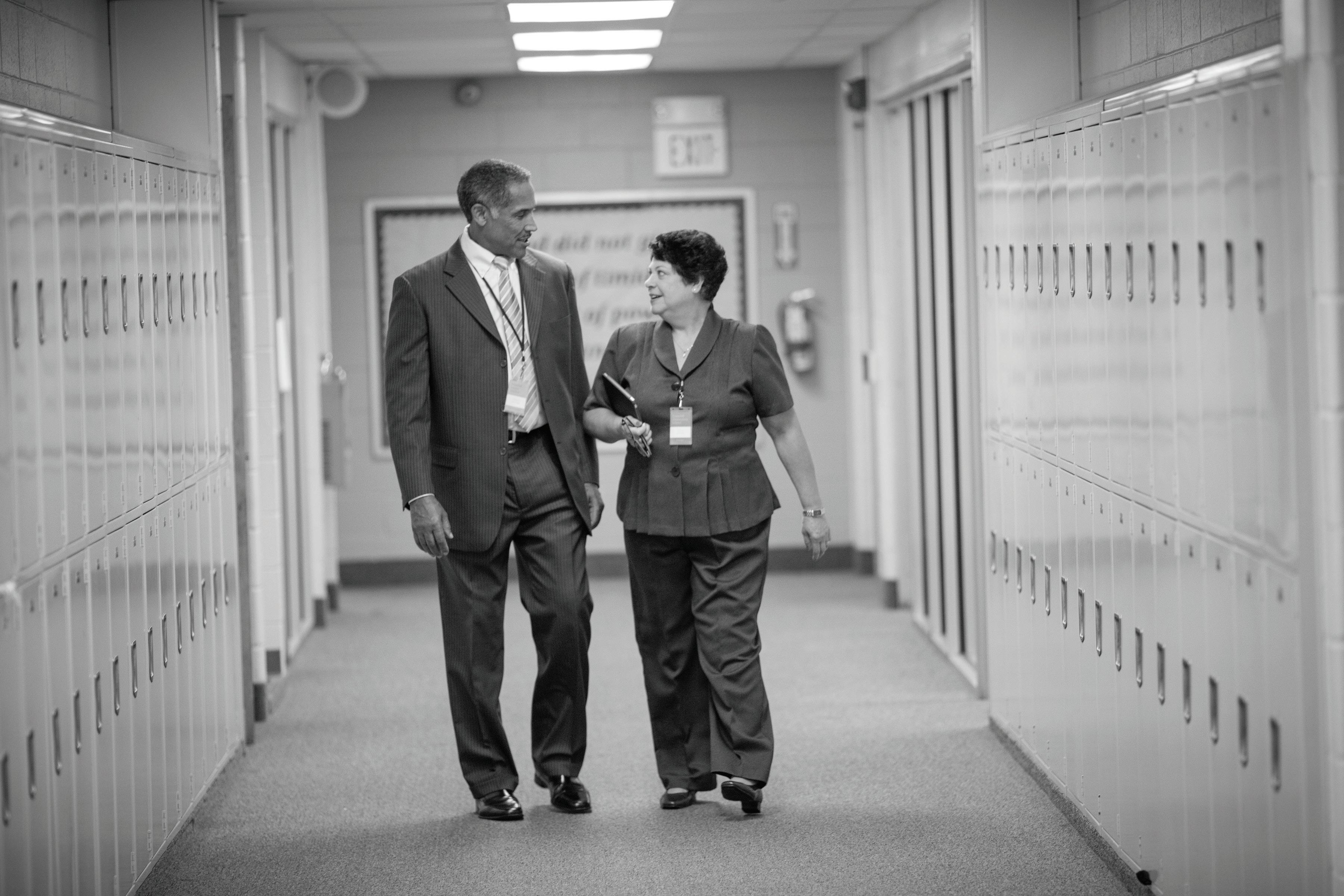
ACCURACY & TRANSPARENCY in Reporting School Construction Financial Information for Key Stakeholders TRACK. MANAGE. REPORT. Visit us online: www.KeyAnalytics.org Smart business Smart schools
Terilyn Finders
She’s passionate about helping education leaders respond to crises
By Jennifer Snelling

AFTER THE CATASTROPHIC TUBBS FIRE
IN 2017 , Terilyn Finders, chief client services officer for F3 Law, spent a week in Santa Rosa helping the superintendent and public information officer communicate with the community, staff and families about the crisis.
Although not a lawyer herself, Finders joined F3 Law, a CASBO Premier Partner, 14 years ago as a communications specialist. At the time, the flow of information schools were dealing with was speeding up exponentially thanks to social media. Finders stepped in to help leaders communicate effectively during campus lockdowns, environmental disasters and other difficult situations.
“Lawyers are there to protect schools in the court of law, and I deal with the court of public opinion,” explains Finders. “We blend our work in service of the many districts we work with in California and beyond.”
Finders began her career at what was one of the nation’s largest public relations firms. New York’s Burson Marsteller spearheaded the response to the Tylenol tampering crisis, and Finders learned from their experience. She now has an extensive skill set in crisis communication and education, experience she shares with CASBO members through workshops on communications and leadership.
“Whenever we worked in controversy, the rules were: Grab the facts, tell the truth, lean in and tell what you will do about it,” says Finders. “I find I borrow from that so often in my work in education.”
When Finders and her family moved to Southern California, she began reporting on education. That experience led her to run for the Las Virgenes Unified School District School Board of Education. She recalls that board meetings initially felt like drinking from a fire hose, but she soon found her way. The team she worked with built schools, relocated a school, renovated campuses and built a stronger, more productive relationship with the district’s teacher unions.
“Changing anything from curriculum and instruction to personnel to facilities is like repairing an escalator in use,” she says. “I gained an increased understanding of the complexity of education, and I have a real reverence for people who work in education. It’s a cause, and that’s what motivates me.”
Finders’ young family moved to California after her husband, Matt, was invited by Branford Marsalis to join “The Tonight Show” band. Still a busy musician, Matt also enjoys volunteering at Livermore High School, teaching jazz band. Her two daughters, who were students when Finders served on the board,
didn’t always appreciate their mom’s work. She handed them their lunch, kissed them and reminded them not to break any rules she helped write.
Today, Finders’ youngest daughter, Hannah, is a rehabilitation therapist, and her older daughter, Beth, is expecting her second child. It’s Beth, a busy mother, that Finders channels when crafting school communication strategy. Finders imagines Beth getting a message from school while shuffling kids between appointments and lessons, and strives to deliver the honest and concise information parents and caregivers need.
Finders is called to help manage difficult situations, such as a threat of violence, allegations of abuse, or a school shooting, but that doesn’t change the optimism she feels about education.
“While education faces some difficult issues that attorneys and I help leaders deal with, it’s only a small slice of what’s happening in schools,” says Finders. “Education plays a profound role in shaping people’s confidence, love of learning and life trajectory. I’m grateful to everyone who works in public education because they’re contributing to our democracy and our future.” z z z
California School Business casbo.org 25 IN FOCUS

Through sophisticated investment banking services and distinctive client service, we are committed to help build the future of education in California. Our team brings experience, professionalism and integrity to financing K-12 school bond programs in the state of California. With offices in Los Angeles, Pasadena, San Clemente and San Francisco, we pride ourselves on providing creative solutions, quality service and low borrowing costs, supporting our clients’ efforts to act as true stewards of taxpayer dollars. Let us put our experienced local team and deep resources to work for you.


For almost four decades, SELF has helped protect California's schools from catastrophic liability losses through the conservative management of public funds.
26 California School Business Spring 2024
Dedication.
RANDY MERRITT, Managing Director 949.485.5903 // randy.merritt@raymondjames.com JOHN R. BARACY, Managing Director 424.303.6406 // john.baracy@raymondjames.com
Innovation. Results.
SUSTAINABLE

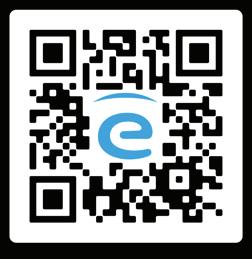









California School Business casbo.org 27 Comprehensive • Funded • Assured SUSTAINABLE ENERGY PROGRAMS FOR CALIFORNIA SCHOOLS Learn more at: solutions.engie-na.com/CASBO Campus Modernization & Efficiency Renewable Energy Generation School Bus Electrification Energy Storage & Resiliency
 Photography by Radical Candor
Photography by Radical Candor

Kim Scott
Author and work culture expert explains Radical Candor’s role in education
By Julie Phillips Randles
Kim Scott’s upcoming keynote address at the 2024 CASBO Annual Conference & California School Business Expo in April will be full of stories and advice about how to succeed at work without losing your humanity.
Scott developed Radical Candor –the idea of caring personally and challenging directly – to help people avoid the kinds of communication wipeouts she’s experienced in her career. She’ll explain why too much challenge and not enough kindness leads to “Obnoxious Aggression.” But kindness without challenging your fellow school leaders to grow leads to “Ruinous Empathy.” And behavior free of both caring and challenging will land you in “Manipulative Insincerity.”
We all want to avoid doing things that are obnoxious, ruinous or manipulative, and Scott’s got the pro tips you need to stay out of trouble.
“This is not another Myers Briggs personality test,” Scott told bloggers at Dropbox. “These are a series of mistakes that we all make all the time.” The key, she says, is to find that happy medium where you give more praise than criticism, but don’t shy away from sharing the things that might be hard to say but will help your colleagues grow.
A CEO coach at Dropbox, Qualtrics and Twitter, and a former member of the faculty at Apple University, Scott also led AdSense, YouTube and DoubleClick teams at Google. (Prior to that, Scott
managed a pediatric clinic in Kosovo and started a diamond-cutting factory in Moscow – yet another way to define a radical career.)
She’s currently co-founder of Radical Candor, and author of Radical Respect: How to Work Better Together and Radical Candor: Be a Kick-Ass Boss Without Losing Your Humanity. And she’s helping audiences, too, on her “Radical Candor” podcast.
She earned her bachelor’s in Slavic literature from Princeton University and an MBA from the Harvard Business School. But most importantly, she’s been on both sides of Radical Candor.
When Scott reported to Sheryl Sandberg at Google, Sandberg took her aside and pointed out Scott’s annoying
California School Business casbo.org 29
INTERVIEW
Kim Scott
When you apply Radical Candor, it will help you do the best work of your life and build the best relationships of your career.
verbal habit of saying “um,” but she shrugged it off.
“Finally, Sheryl said, ‘You know, Kim, I can tell I'm not really getting through to you. I'm going to have to be clearer here. When you say 'um' every third word, it makes you sound stupid,’” Scott recalls the incident often in interviews.
Similarly, a stranger who witnessed Scott grab her puppy out of traffic just in the nick of time told her, “I can see you really love that dog, but you’re going to kill her if you don’t teach her to sit.”
Truth bombs wrapped in velvet.
Yet Scott is no stranger to finding the right mix. When she owned a software company, she praised one employee for 10 months even though he wasn’t doing good work. She never gave him kind and clear criticism to help him improve, and lost the trust of her team. After she fired him, he replied, “Why didn’t you tell me before? I thought you all cared about me!”
“It was probably the worst moment of my career,” she notes today. Her Ruinous Empathy is one of the reasons the software company failed. As Scott says, when you apply Radical Candor, it will help you do the best work of your life and build the best relationships of your career.
We sat down with Scott to discuss how you can apply Radical Candor in the education setting.
What are you currently reading or learning about that excites you?
I think this is going to be a hard year, so to prepare myself, I’m reading utopian literature about what an ideally functioning society could look like.
How did your experience at Google and Apple shape your approach to leadership and communication?
If you read the S-1 Form Larry (Page) and Sergey (Brin) wrote before Google
went public, you'll see that the core of the company's philosophy is caring about the people who work there. That was very refreshing to me because before I joined Google, I had worked on some startups that were rather short on the concept of “care personally.” And I had worked in finance where sometimes it just felt plain abusive. So, the care personally part was the first thing I noticed about Google when I was doing my due diligence before starting there.
When I got there, the second thing I noticed was that people were very open and respectful when they disagreed with one another. There were not a lot of meetings after the meeting. If you were going to add someone to an email, you put a plus in the person’s name at the very top. So there was a lot of what I call respectful disagreement.
In fact, shortly after I joined Google, I got to know Matt Cutts who was in charge of webspam, and I really liked him. Matt and I sort of were aligned on a particular policy we thought Google should take on the AdSense network, but Larry had a different point of view. Matt and I went together to talk to Larry, and Matt started yelling at Larry, and I had this cringe moment where I thought, “Oh my gosh, my new friend is gonna get fired.”
And then I looked at Larry and he had this big grin on his face. He was sort of encouraging Matt to share his point of view. I realized that this was not seen as disrespectful – that the most productive, respectful thing Matt could do was share as openly as he could what he thought the company should do. The fact that Larry was not just willing to permit this disagreement, but encouraging it, was really kind of revelatory and refreshing for me.
I saw it happen another time when Google was changing the AdWords front end, and at that time AdWords was
30 California School Business Spring 2024
responsible for about 99% of Google's revenue – so it was a big deal. They wanted to get it right. The team that was working on it wanted to do it one way and Sergey, wanted to do it another way. Sergey said, “OK, I understand what you're saying, but why don't you just put five or six engineers on it and let's do two experiments.” And the team didn't want to do that either. And at one point, Sergey kind of banged his fist on the table and said, “If this was an ordinary company, you'd all be doing it my way, I just want five or six people.” He’s human, of course, and part of him was frustrated, but he also had this larger goal of creating an organization where everyone felt not just safe, but encouraged to say what they really thought. And Sergey did not
get his way in the end. And that was sort of revelatory.
Apple has a very different culture than Google in a lot of ways, but there was this similarity around care personally and challenge directly. There's a famous interview with Steve Jobs where he said that at Apple we don't hire people so we can tell them what to do. We hire the kind of people who will tell us what to do. And this was really true.
If the company was moving toward a launch and there was a recent college grad who'd been hired to work on a particular feature, and Steve Jobs had a question about that feature, he’d show up at the guy's cubicle after lunch and ask him. So I think both companies had what I would call a radically candid culture,
They wanted to get it right.

California School Business casbo.org 31
®
exible furniture
virco.com • 800-448-4726 ©2022 Virco, Inc. REF# 22001
Virco leads the way in
for today’s evolving classrooms.
Kim Scott
You want to start by soliciting criticism from all of the people you’re serving.
where the leaders really did care personally about their direct reports and about the employees. And at the same time, they were eager to be challenged, and also willing to challenge.
In your book Radical Candor, you emphasize the importance of caring personally, while challenging directly. How can school business officials apply this principle to foster a more effective and compassionate educational environment?
For anyone trying to create a culture of Radical Candor, there's an order of operations, and you always want to start by soliciting criticism. It’s not just soliciting feedback, which could mean praise or criticism, you want to start by soliciting criticism from all of the people you're serving.
This is very counterintuitive because school business leaders are likely already getting a lot of unsolicited criticism from folks. But by making sure that you're taking time to show people that you understand where they're coming from, and rewarding the criticism when you get it – either by fixing the problem and then being very public about what the problem was and what you did to fix it – or by at least sharing with people the interim steps you're taking to address the problem if you agree with the feedback.
If you disagree with the feedback, it’s easy to feel wedged, but look for that 5% or 10% of what the person said that you can agree with and then give voice to that. This makes your listening tangible. Then, offer that person a respectful explanation of why you disagree, why you're not go-

32 California School Business Spring 2024
ing to do what they're suggesting – and then share that explanation more broadly, letting others who disagree or have a different point of view know that you’re open to that. That gives you an opportunity not to have a bunch of one-on-one conversations over and over again.
When you solicit criticism publicly and you offer a respectful explanation of why the situation is the way it is, they may not love it, but they at least don't feel just brushed off.
Also, being very aware of giving praise to your colleagues that's meaningful, and being specific and sincere about your praise, is critical. You can use the context, observation, result, next steps approach. Here’s an example: “In the last semester, I noticed that we've cut costs for school supplies by 5%. That's going to help us keep on budget. Let me know if these cuts are causing a problem.”
Then you want to make sure that you're offering private criticism to people when you notice problems. One thing that happens in very mission-driven organizations like schools is that there’s a reluctance to share critical feedback, and you have to remember that it’s actually kind to share critical feedback, if you do it in the right way and as long as you do it in private. You have to be humble and not assume you know everything. That's why I call it Radical Candor and not radical truth, because to me, candor implies more of a conversation.
You can offer that kind of feedback by stating your intention to be helpful to the person. You’re not trying to demonstrate that you're better or more dominant. Instead, you’re saying, “You know, I can tell you really care about what's going on. I have this observation and it will help you support students better.” Make sure you’re offering this feedback right away, that you're not hanging on to it – that it's immediate.
In the before times, I used to recommend having these conversations in person. That's not always possible now. At the very least, pick up the phone, so you're having a synchronous phone call; don't send an email or text.
Again, praise in public, criticize in private. And don’t give people either praise or criticism about their personality. For the same reason it's not a good idea to say, “You're a genius,” it’s also not a good idea to say, “Ah, you're an idiot.” Then, make sure you're gauging how it's landing. Because sometimes the other person is going to be sad or mad and that's your cue to move up on the idea of care personally. Other times, the person is going to brush you off, and that's your cue to move on challenge directly.
What's the biggest mistake leaders make when trying to deliver Radical Candor?
One of the most common is that people mistake radical candor for acting like a jerk. Sometimes I'll be working with a team and somebody will charge into a conference room and they'll say, “In the spirit of Radical Candor …” and then they will proceed to act like a garden variety jerk. That’s not the spirit of Radical Candor.
So, it's really important to think about what Radical Candor is, but also what it's not. If you imagine a two-bytwo framework and on the vertical axis is “care personally” and on the horizontal axis is “challenge directly,” when you're caring and challenging, that’s Radical Candor. When you're challenging but you're not showing that you care, that's Obnoxious Aggression – not Radical Candor. And when you're neither caring nor challenging, that's Manipulative Insincerity.
Sometimes the most common mistake we make is that we remember to
That’s why I call it Radical Candor and not radical truth, because to me, candor implies more of a conversation.
California School Business casbo.org 33
Kim Scott
Make sure you’re soliciting feedback and rewarding the candor when you get it.

show that we care personally, but we're so worried about not offending someone or hurting someone's feelings that we fail to tell them something they'd be better off doing in the long run – and that's an example of Ruinous Empathy.
What qualities and skills are most important for leaders who want to foster a culture of Radical Candor within their teams?
This really is a skill-based thing, rather than a list of personality attributes, and there are specific things you can do to foster a culture of Radical Candor. One is the order of operations I discussed – make sure you're soliciting feedback and rewarding the candor when you get it. Make sure you're giving a lot of praise and that you're focusing on the good stuff. Make sure that you’re giving criticism about things that really matter in a way that shows you care. And make sure you're adjusting how you're talking to the other person.
But there are also a couple of other things that leaders can do. One thing is to make sure that you are preventing backstabbing in your organization. For example, if one person comes to you to complain about another person who's not in the room, it’s tempting to think you’re being an empathetic leader by listening. But this is one time when listening is actually a really bad idea.
What you want to do is encourage those two people to talk directly to each other. So, if I come to you and I’m complaining about Bob, your first question to me should be, “Have you spoken to Bob about this?” And if I say, “No, I don't like talking to Bob,” your first request should be, “Please try to talk to Bob directly, and if you can't work it out, you can both come to me together.”
In other words, you're not going to allow me to backstab Bob when he's not
there, but you will help us resolve the conflict if we come to you together. That’s sometimes called joint escalation, but I prefer the term clean escalation.
Another thing you can do if you’re a leader of leaders is to make sure it’s safe to speak truth to power; that not only are you rewarding the candor, but you're teaching the people who work for you to reward the candor when they get it – so that people know they’re supposed to speak truth to power in your organization.
School business officials often face difficult conversations, whether it's about budget cuts, resource allocation or policy changes. What advice can you share for handling these conversations with empathy and effectiveness?
The first bit of advice I have is to share bad news early. It’s so tempting when you have to communicate something that's going to be unpopular to delay, delay, delay. That’s a huge mistake that will really erode trust in your organization.
The second bit of advice is to avoid trying to get on the same side as your team. For instance, by blaming the outside authority that has changed a rule by saying, “Oh, stupid FDA.” That can backfire because then it looks like there’s nothing you can do as a leader.
One of the things you can do if you have to communicate something that perhaps you disagree with or that you know is going to be unpopular is to take the extra time to understand the reason for this decision that’s sort of rolling downhill. You may disagree with it, but if you’re tasked with implementing it, do everything in your power to make sure that you understand the reasons for it.
If you disagree with a decision that you have to implement, you don't have to pretend to agree with it. But you can say, “Look, I wish that things were differ-
34 California School Business Spring 2024
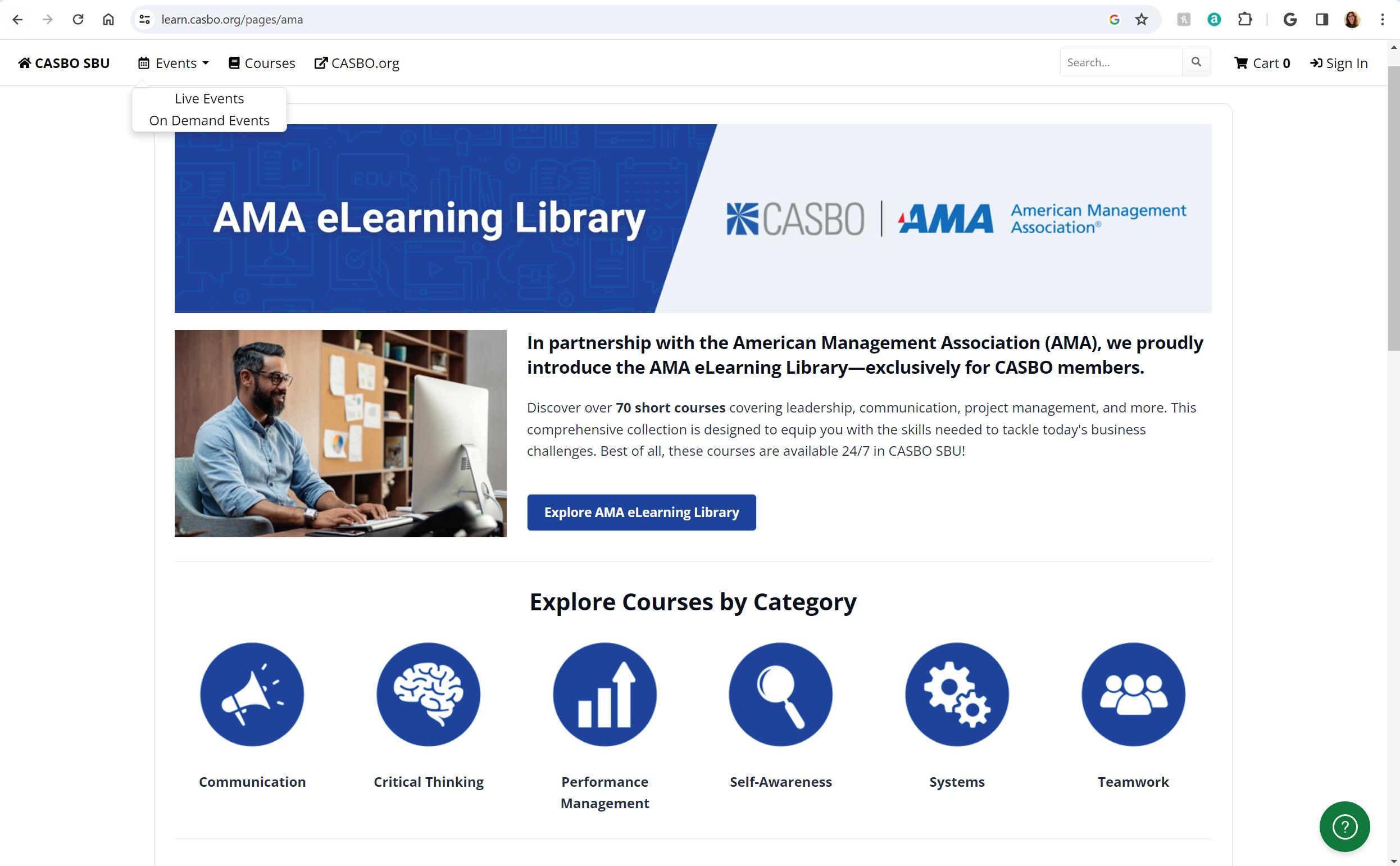
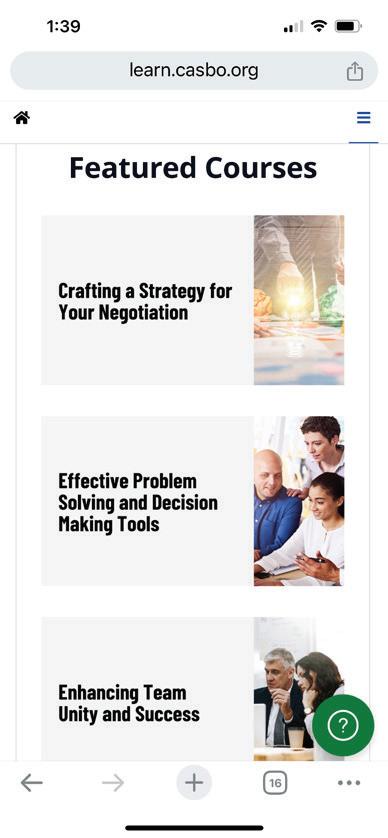
Expand your skillset with 70+ new courses in CASBO’s AMA eLearning Library
Now available exclusively for members on CASBO School Business University (SBU). Choose from 70+ courses presented in partnership with the American Management Association (AMA) on topics including leadership, communication, project management, and more. The comprehensive collection is designed to equip learners with the skills to tackle today's school business challenges. Best of all, CASBO SBU courses are self-guided and available 24/7 on-demand.

California School Business casbo.org 35
The foremost authority in school business
the QR code for more information or to get started today.
Scan
Kim Scott
With Radical Candor, you need to notice the other person’s humanity in the moment.
ent, but they aren't different. And I have taken the extra time to talk to so and so, and here's what I understand from them. Here are the reasons for this decision.” And then get advice from your team on what's the least painful way to roll out this decision.
That way, people feel like even though they have to implement something they're not excited about or maybe even disagree with, they have some agency over how they implement that decision.
What are the key strategies school business officials should use to build strong, positive relationships with educators, students and the community? The good news about Radical Candor is that you can put it into practice without having a deep relationship. I mean, relationships don't scale – there are only so many hours in the day and a real relationship takes real time. With Radical Candor, you need to notice the other person's humanity in the moment. The origin story of Radical Candor happened with a perfect stranger in the space of time it took a streetlight to change in Manhattan.
I had just gotten this puppy and I loved her so much that I had never said a cross word to her and, as a result, she was totally out of control. That day, I was taking her for a walk and she jumped in front of a speeding cab. I pulled her out of the way in the nick of time, and this man, a perfect stranger, looked at me and said, “I can tell you really love that dog.” That was all he had to do to move up on the “care personally” dimension. He didn't have to know me for years on end. He didn't have to take me out for lunch. He didn’t need to know my birthday. None of that. He just needed to notice what I was caring about in that moment. That was it, and now I was going to listen to what he said next.
Then he said, “You’re going to kill that dog if you don't teach her to sit.” And he pointed at the ground. It was kind of a harsh gesture and he said, “Sit!” and the dog sat. I had no idea that she even knew what that meant. I looked up at him in amazement, and he said it's not mean, it's clear. And then the light changed and he walked off, leaving me with words to live by.
Radical Candor is often about these two-minute conversations, and often two-minute conversations with people who you don't know that well, but you can still pause and notice what's going on for them in that moment. It's about being fully present for someone in the moment when you're working with them.
It's funny when I was working at Apple, my boss came in one day and I was having lunch at my desk and said, “How is it that you know all these people and have all these relationships when you never go out to lunch with anyone?” And I said, “You know, in a career it's not having lunch with people that builds the relationship, it’s how you work with them while you're working.”
How important is ongoing professional development for educational leaders, and what role does feedback play in this process?
Professional development is vital. It’s so important for leaders because, if you think about it, leadership is learning how to manage people – and there’s no degree for it. I went to business school and there were zero classes on managing people. I learned a lot about finances, operations, marketing, but managing people is something that we are just not taught to do until we're doing it. And the problem with that is that, often, someone who's a good person winds up being a bad leader because they don't know what they're supposed to do as a leader.
36 California School Business Spring 2024
All we do is throw people in the deep end of leadership. Then, not only does that individual sink, but they drive their whole team down with them. I would love to see a proper degree that teaches people what good management looks like. How do you solicit feedback? How do you make sure you're rewarded for candor? How do you give praise so that it has meaning? How do you give criticism? How do you have a 360 review process? How do you have a one-on-one? There’s a lot to learn.
How can our readers learn more about Radical Candor and understand how to implement it successfully?
We've developed some artificial intelligence-based resources to help. One is a large language model that you can ask questions of, and it’s trained with the books Radical Candor and Radical Respect, and the “Radical Candor”podcast and blog. You can ask it a question and it will give you an answer and let you know where you can read more.
We’re also working on an AI practice partner. Folks can go to RadicalCandor. com/resources to download our free learning guides, sign up for Radical Candor on MasterClass, get our Radical Candor LIT videobook, register for our workplace comedy series and e-course The Feedback Loop, and more.
Tune into our weekly Radical Candor podcast (available wherever you get your podcasts) for in-depth conversations about communication at work, leadership and management, and workplace culture. We also have a blog on our website, a YouTube channel and you can subscribe to our newsletter at RadicalCandor.com/news. z z z
Julie Phillips Randles is a freelance writer based in California.

•
•
•
•
•
•
•
•
•
OUR FIRM is dedicated to helping clients stay ahead in an everchanging world; because, like you, we know staying up-to-date on the issues impacting education today results in classrooms that excel.
To learn more about our mission to educate, visit us at f3law.com.
California School Business casbo.org 37
FRESNO | INLAND EMPIRE | LOS ANGELES | MIDWEST OAKLAND | SACRAMENTO | SAN DIEGO ©2024 Fagen Friedman & Fulfrost LLP
Business, Facilities & Construction
Communications & Media Relations
Education Technology
Governance & Leadership
Government Affairs & Public Policy
A MISSION TO EDUCATE •
•
•
•
•
Interscholastic Activities
Labor & Employment Law
Litigation
Next Level Client Services
Real Estate & Property
Special Education
Student Rights & Discipline
Title IX & Investigations
Virtual Learning









38 California School Business Spring 2024 With the goal of creating healthy, comfortable indoor environments to promote productivity, increased output, and improved experiences, Improving Education by Improving the Learning Environment Learn more about our education enhancement solutions. SitelogIQ.com Self-Performance of Work Guaranteed Workmanship & Savings Guaranteed Fixed Cost U.S. Owned Company Sustainability Safety Financial Solutions Manufacturer Agnostic Simplify buying for education Amazon Business combines the selection, convenience and value customers have come to know and love from Amazon, with unique needs of schools. Visit business.amazon.com to learn more. Educator pricing Flexible payment options Bulk purchasing Analyze spend Maintain guardrails

Construction Defects in School Buildings Are Unacceptable
Kasdan Turner Thomson Booth LLP (KTTB) has recovered over $ $1 414 BILLION in construction defects. We represent districts in connection with construction defect disputes concerning all types of school facilities. We pursue General Contractors, Subcontractors, and Design Professionals who may be responsible for defects. Ask us for a No Cost / No Obligation Property Condition Assessment to evaluate potential construction and design issues. We Provide Experienced Legal Counseling On: We
• Delay and Disruption Claims
• Completion Claims
• Claims Against Sureties

• Change Order Disputes
• Mediation, Arbitration, and Litigation of Claims
Designed for today's hybrid classroom, the HP Pro x360 Fortis 11-Inch G10 Notebook, powered by 12th Gen Intel® Core™ i5 processors, delivers:
Built-in reinforcements that help prevent damage from learning on the go
Wi-Fi 6E wireless LAN to keep your students connected Easy-to-use manageability features and HP Wolf Security
Plus, keep your students better focused with the more intuitive user interface, simpler organization, and effortless navigation of Windows 11 Pro.



California School Business casbo.org 39
PC
HP Pro x360 Fortis 11 G10
Providing IT Solutions for 40 Years! Call Sehi for a De mo. 1-800-346-6315 San Clemente California 1-800-346-6315 www.BuySehi.com
Anytime.
Students get right to the tasks with the durability and simplicity they need in a laptop.
Enable Learning On the Go Anywhere,
Better Together arizona n california n hawai‘i**
new
*Admitted in Arizona and District of Columbia Only. **Hawai‘i based practice is in affiliation with Kasdan Turner Thomson Booth LLLC.
n
mexico
866.578.3328 x317 Kenneth S. Kasdan, Esq. Senior Partner kkasdan@kasdancdlaw.com • Construction Defect Claims
KASDANCDLAW.COM
Are Construction Defect Attorneys


Expert tips for navigating school finances during budget uncertainty
Follow these pro tips to get through challenging financial times
By Jennifer Snelling
Budget uncertainty is nothing new for California school districts, but this year, schools are looking at more uncertainty than usual.
Initially, the projections were for a $68 billion state deficit. Gov. Gavin Newsom then came out with a more optimistic projection and pledged to protect schools from cuts.
The current discrepancy between the governor’s projections and the Legislative Analyst’s Office (LAO) estimate is $21 billion (as of publication). Newsom believes the economy with recover more quickly, while the LAO remains cautious.
The state has pledged to use postCOVID revenues to continue to pay for universal transitional kindergarten, and appropriate $8 billion to create community schools and add summer programs and after-school hours for low-income students. In addition, $300 million is earmarked for the state’s poorest schools.
These optimistic plans may change in May, when the next forecast is expected. While districts are used to dealing with uncertainty regarding budgets, this is the first time in a while that cuts may lie ahead.
“If this were May or June and this was the budget, I would grab it and run,” says Michael Fine, CEO of the Fiscal Crisis & Management Assistance Team (FCMAT). “There’s a piece of me that would argue it’s a pretty good budget for schools. But in five months, if revenue is lower and the legislature has weighed in on their priorities, we could see something that is not as good as the governor proposed. Unfortunately, it’s one of those difficult years due to the instability.”
Fine points out that there are a lot of chief business officials in California schools who are new to the profession. FCMAT and those who have been in the
California School Business casbo.org 41 COVER FEATURE
Expert tips for navigating school finances during budget uncertainty
“ My advice is to get your foundational programs locked down and stable.”
school business for a long time have seen this type of uncertainty before.
“We have a playbook for these situations, but the new folks don’t have the playbook,” he says. “Those of us who have been around for a while know what to do in this circumstance, thanks to our experience.”
Fine and Lawrence O. Picus, USC’s professor of education, finance and policy, offer some thoughts on the best way for districts to prepare for a sustainable financial future in uncertain times.
A complicated picture
There are many factors that cloud the financial picture. After last year’s catastrophic floods, the state delayed the tax deadline from April to November, so those numbers are new and lower than expected. Factors outside of California are also contributing – the markets have been sluggish and the war in the

Middle East is causing energy costs to increase.
Picus is an expert in education budgets. Even he says the situation is complicated and includes lots of variables.
Gov. Newsom’s budget depends on withdrawing about $7 billion from the $10.8 billion TK-14 rainy day fund to cover the shortfall in revenue. In addition, the state would not seek reimbursement for funding above the minimum Proposition 98 statutory obligation for the past two years.
These actions would cover all current levels of funding and existing commitments for new and expanded programs, including universal transitional kindergarten and universal school meals.
The governor’s budget also calls for an approximately 1% Cost of Living Adjustment (COLA) (at the time of publication) for next year, after a 8.22% COLA this year. “Any COLA lower than 4.5%-5% is a problem for school districts because their fixed costs go up year to year," says Fine. “While 3%-4% is more in line with historical trends, it’s been a while since California has seen a COLA that low. The prior year was almost 13%, made up of a 6.56% COLA and a 6.28% addition to base funding."
In addition to a decreased COLA, more than two-thirds of districts are facing declining enrollment, meaning they will not receive as much state funding. The situation is complicated by the fact that COVID-era federal Elementary and Secondary School Emergency Relief Funds (ESSER) have to be spent by September.
“This budget deficit comes at a time after robust funding and declining enrollment. Not every district has reduced accordingly,” says Fine. “My advice is to get your foundational programs locked down and stable. This includes regular staffing according to enrollment. Now
42 California School Business Spring 2024
you can figure out the extras and what you can fund at what level.”
Hopefully, the economy will have a soft landing and the worst fears will not be realized. If districts are careful with the resources they have, they should be able to make it through the year without too much difficulty, says Picus.
“If I were a superintendent, I would think I better be very careful,” he says. “It makes it hard to hire or take on new initiatives.”
Preparing for lean times
Both Fine and Picus have lots of experience shepherding districts through difficult financial times. Below is advice from both experts.
1. Build reserves
Districts should look to cut expenses now and build up reserves for July 1, including cash reserves. If the state returns to deferrals, then school districts need cash to counter that.
“Reserves don’t solve problems, but they allow you time to resolve problems in a thoughtful way,” says Fine. “Reserves allow districts not to overreact to the governor’s proposal. If revenues drop more than expected, districts can use reserves to buy time to do planning, make decisions and implement.”
2. Map out multiple projections
When making multi-year financial projections, use multiple scenarios. For example, worst case scenario would be $100 per kid less at the local level. The best case is 1.2% COLA and no revenue reduction. Then run a few numbers in between. Once you have a best- and worst-case scenario, have a conversation with leadership teams about the best ways to approach each of these scenarios.
3. Don’t overreact
Fine advises against issuing a bunch of layoff notices on March 15 because it causes a massive hit to morale. At the same time, if your district is experiencing declining enrollment, don’t ignore that reality. Adjust staff to the appropriate number for the students you have. Reserves will carry a district to the following year, then March 15, 2025, is time to take action. At that point, there will be more data to help inform the decision.
“The ESSER one-time federal money allowed districts to afford Cadillac staffing,” says Fine. “Now is the time to look at the upper end of Chevy and Fords, but you don’t have to go all the way to the back of the car lot.”
4. Don’t commit to long-term spending
Given the uncertainty, districts are not sure what money they will have longterm. It’s not the time to take on big, expensive new initiatives.
Starting an initiative that has to be cut the next year is more harmful than helpful. The longer-term commitment you can make to each priority, the more likely it is to be implemented with fidelity. Make sure any new initiatives have time to take hold.
5. Maximize the money you have
A new cycle is a great time to look at priorities. Programs that are not giving a return in moving the needle should be rethought.
“Many districts used ESSER money to implement new programs that work. It’s a new world and time to look at what programs could be replaced. There’s a lot of research about what works best in schools,” says Picus. “We know tutors for struggling students, access to tutors during the day, and academic coaches to help teachers be better teachers all work.
“ Now is the time to look at the upper end of Chevy and Fords, but you don’t have to go all the way to the back of the car lot.”
California School Business casbo.org 43
Expert tips for navigating school finances during budget uncertainty
“ Use your network to pay close attention to what is happening in Sacramento.”
There’s also growing evidence that we need to invest more heavily in counseling and guidance services for children. Finally, technology and access to the internet are essential learning tools.”
6. Think about messaging
While it is good news that the governor says there will be no cuts to education, the current level of funding doesn’t pay for the next year at the local level because the cost for current programming goes up each year.
This can lead to a disconnect between what communities hear from the media say, “No cuts to school budgets,” and what they hear from their local school, “Whoa, we are struggling.”
This disconnect is especially true with bargaining. For a local superinten-
dent to explain why the district can’t afford an 8% raise takes multiple paragraphs and charts. Whereas teachers just feel that they aren’t being valued. Try to be as clear, honest and concise as possible with all stakeholders.
7. Pay attention
Use your network to pay close attention to what is happening in Sacramento. You don’t want to hear news two weeks after it happens. Give your district time to adjust to any new realities.
While the Legislature and governor wrangle through an exhaustive list of priorities, schools can and should advocate for themselves. To this end, it is extremely helpful to speak with one voice. For example, if advocates come together to request the state fully fund COLA or don’t

44 California School Business Spring 2024
make cuts to education, they are more likely to be successful if advocating for one thing. Schools, after all, know what works their students and communities.
“We know a lot more after COVID. How do we fulcrum that to help children learn?” Picus asks. “Not all of it costs a lot of money. It may just mean providing internet access or supporting students in a different way. These are very hard decisions. I’m hopeful this will not be an actual decline in dollars, just less than we think we need.” z z z
Jennifer Snelling is a freelance writer based in Eugene, Oregon
How are you navigating challenging budget times? Email us at instight @ casbo.org for a chance to be featured in an upcoming story.

California School Business casbo.org 45
Unlock Results with Brightly’s Asset Management Solutions Giving maintenance and operational teams tools to make the honor roll
more at: brightlysoftware.com/casbo
Learn








WE GE T THE CLASSROOM LOOKS DIFFERENT.
To transform learning through cloud technologies, you need IT Orchestration by CDW®.
The cloud helps keep classrooms connected — no matter where learning takes place. From secure, real-time collaboration among students to enhanced workflows for administrators, see how CDW can help your organization leverage cloud technologies and accomplish more every day.
46 California School Business Spring 2024
how at CDW.com/education Smart business. Smart schools. Education
See


Let us take care of the financing, so you can focus on the project at hand. The Certificates of Participation and Lease Program can assist you with raising the capital funds you need to get moving on your highest priority property acquisitions, classroom construction projects, equipment purchases and more.

California School Business casbo.org 47 Get moving
us
Our
offers:
Fast and efficient financing
Non -bonded debt
Competitive
Tax-exempt
Full asset ownership California School Boards Association | 3251 Beacon Blvd. West Sacramento, CA 95691
on critical projects
Contact
to find out more 800.266.3382 ext. 2603 | www.csba.org/cop
program
»
»
»
interest rates »
payments »


48 California School Business Spring 2024



California School Business casbo.org 49 Explore Carahsoft’s Best-of-Breed Education Technology Solutions Portfolio Carah.io/EdTech4CASBO The Trusted Education IT Solutions Provider TM Committed to helping educators Explore your opportunities. Visit equitable.com/educators. Your dedication to helping children realize their potential and achieve their dreams is remarkable. We want to help you work toward achieving a meaningful retirement through a tailor-made strategy for educators. Since 1859,* Equitable Financial has helped people build and secure their financial futures. Our 403(b) plan is designed to meet the specific needs of public service professionals. That’s just one reason why we are the #1 choice for K–12 educators.1 * Applies exclusively to Equitable Financial Life Insurance Company. 1 LIMRA, Not-for-Profit Survey, Q1 2023 results based on 403(b) assets, participants and contributions. Equitable is the brand name of the retirement and protection subsidiaries of Equitable Holdings, Inc., including Equitable Financial Life Insurance Company (Equitable Financial) (NY, NY); Equitable Financial Life Insurance Company of America (Equitable America), an AZ stock company with an administrative office located in Charlotte, NC; and Equitable Distributors, LLC. Equitable Advisors is the brand name of Equitable Advisors, LLC (member FINRA, SIPC) (Equitable Financial Advisors in MI & TN). © 2024 Equitable Holdings, Inc. All rights reserved. GE-5368914.1 (12/22) (Exp. 12/24) | G2459700 (1/24)

50 California School Business Spring 2024

Focus on efficiencies to thrive
When asked to do more with less, pinpoint efficiencies
By Jennifer Fink
“The more efficient you are at doing the wrong thing, the wronger you become.”
That quote, from Russell L. Ackoff, a pioneer in the field of operations research, systems thinking and management science, is worth keeping in mind as you create a budget for the coming school year. School business leaders will most certainly be tasked with finding efficiencies as pandemic-era funding dries up.
Thanks to declining enrollment in many parts of the state, many districts will also receive less state funding than in previous years. The proposed 1% inflation adjustment (at the time of publication) for 2024-25 will not cover cost increases, so school leaders will (once again) have to get creative. School business officers, superintendents, department heads and educators will be asked to find efficiencies – asked, essentially, to figure out how to do more with less.
As you explore options, remember: Finding more efficient ways to do the wrong things won’t help your district. In fact, “efficiencies” that fail to advance your district’s goals may ultimately harm your district.
“Guideline No. 1 is ‘don’t do the wrong thing,’” says Micheal Fullan, professor emeritus at the Ontario Institute for Studies in Education/ University of Toronto, co-director of New Pedagogies for Deep Learning and co-author of Coherence: The Right Drivers in Action for Schools, Districts, and Systems.
Identifying the right thing, though, can be difficult, given the many services school districts provide to students and families.
“School districts have been asked to do everything,” says Margarite Roza, Ph.D., director of the Edunomics Lab at the Georgetown McCourt School of Public Policy. “When money becomes
California School Business casbo.org 51 FEATURE
Focus on efficiencies to thrive
School districts should focus on their mission: Educating children.
tighter, I think one thoughtful approach is to use this moment to really focus.”
School districts, she says, should focus on their mission: Educating children. So, although school business officials typically don’t focus on reading and math scores, it’s necessary to seriously consider your district’s academic outcomes.
“Are your kids back on track from where they were before the pandemic?” Roza asks, noting that “the public loses confidence” when students don’t make adequate academic progress, which then “jeopardizes our ability to convince taxpayers to vote for more money going forward.”
School business officials and educational leaders must collaborate to identify efficiencies that will advance student learning. Here are some ideas to
help you pinpoint efficiencies that make sense for your district:
Use data to focus
During the COVID-19 pandemic, schools and districts experimented with many different technologies, interventions and work modalities. These experiments were driven by necessity and fueled by pandemic-era funding. Now, it’s time to carefully examine the impact of these efforts.
“During that time of the fire hose of cash, we had the luxury of trying lots of things,” Roza says. Some schools added counselors; others invested in socio-emotional learning curriculum. Some districts added extra professional development days; others hired more

52 California School Business Spring 2024
teachers. Roza says districts should carefully analyze the impact of these investments to determine which ones to continue and which to cut or scale back.
“Let’s check the data to see whether having more professional development for teachers on reading turned around reading scores,” she says. If not, it may make financial (and educational) sense to invest that money elsewhere. Similarly, if adding mental health counselors meaningfully reduced student absences and disruptive behaviors, it’s likely a good idea to maintain – or perhaps even expand – your counseling staff. If not, cuts may be in order.
Try zero-based budgeting
Instead of simply rolling over your budget and tweaking it from there, Keith Butler, chief business officer at Torrance Unified School District, suggests using zero-based budgeting.
“Look at it from the ground up. What is the minimum necessary in order to be legally compliant, to take care of the safety of our students? When you build from the ground up, you get a whole new look at the situation,” Butler says.
Encourage your departmental heads to use zero-based budgeting as well. “You can go to maintenance and operations and say, ‘We’re going to do a zero-based budget for next year. Let’s start talking about what exactly you need to do, and let’s build a budget rather than trying to just cut at the edges,’” Butler says. And zero-based staffing
You can use a zero-based approach to staffing, too. Although it is difficult to let go of employees (particularly good employees with a solid work history), declining enrollments mean that many districts will not need as many staff members as in previous years.

“It’s going to be really important for school districts to use this time to eliminate excess capacity in their systems,” Roza says, as districts that fail to appropriately downsize will end up “spending their money on excess capacity and won’t be able to keep their focus on student outcomes.”
Roza recommends using software to determine how many staff members are needed to deliver required classes and services, and then staff and schedule accordingly.
“I think the default for most districts is to start with what they did the year before and then, if needed, they cut their budget, procurement contracts, afterschool providers – anything that’s not in their direct labor pool,” Roza says. “There’s almost this loyalty to employees first, and then, ‘how should we spend our money on kids?’ That approach might feel easier, but it’s not a student-focused approach.”
Invest in educators
Although it may seem counterintuitive to increase spending during tight times, allotting funds to a teacher residency
What we’ve seen in the data is that folks who have not had full teacher training leave in the first year at rates two to three times the rate of folks who come in with training.
California School Business casbo.org 53
Focus on efficiencies to thrive
During that time of the fire hose of cash, we had the luxury of trying lots of things.
program may be smart. Many districts that have hired teachers on an emergency permit have experienced high rates of (expensive!) teacher turnover.
“What we’ve seen in the data is that folks who have not had full teacher training leave in the first year at rates two to three times the rate of folks who come in with training. And then it costs districts anywhere from $20,000 to $30,000 per recruit to replace the person who’s left,” says Linda Darling-Hammond, Ed.D., president and CEO of the Learning Policy Institute and president of the California State Board of Education.
In contrast, districts that participate in teacher residency programs invest about $20,000 per teacher, while the state contributes $40,000 to the teacher’s
education. Because teacher residents are well-prepared and well-supported – and because many teacher residents are already firmly based in (and committed to) their communities -- retention rates are remarkably high.
“Some districts have figured out that they’ve saving a lot of money because of the high retention rates,” DarlingHammond says. “And some are plowing the money they save back into the teacher preparation process.”
Embrace technology
Technology is an integral part of business and education today, so school business leaders should work closely with tech leaders, says Keith R. Krueger, MPA, CAE,

54 California School Business Spring 2024


School Services of California Inc. (SSC) is the leading provider of consulting, governmental relations, and information services for K-14 educational agencies in California. Since 1975, SSC has been proud to provide services to nearly every educational agency in the state.
• Management Consulting Services
• Governmental Relations Services
• Collective Bargaining and Factfinding Services
• Executive Searches and Recruitment
• State Budget Conferences and Issue-Specific Workshops
• The Fiscal Report and Specialized Publications




California School Business casbo.org 55
Smart business Smart schools
1121 L Street, Suite 1060 Sacramento, CA 95814 (916) 446-7517 www.sscal.com
Focus on efficiencies to thrive
Don’t focus solely on cutting expenses. Think about how to boost revenue.
chief executive officer of the Consortium for School Networking (COSN). That collaboration is necessary to ensure interoperability of district technology and to protect schools and districts from (potentially costly) cybersecurity threats.
“On the backend, we spend a huge amount of time and effort retroactively making things talk to each other,” Krueger says, noting that it’s much more efficient, in the long run, to invest in technology that works with other technology in the district.
It’s also time to start exploring artificial intelligence (AI). Although AI isn’t yet ready for primetime use in all areas of education, Krueger says “there’s a huge opportunity” for school districts to use generative AI (like ChatGPT) for hundreds of tasks, including things like constructing bus, cafeteria and student schedules, for example. “With the caveat that you have to use what it produces as a first draft,” he says. CBOs (or others) can then provide additional instructions or parameters and use AI iteratively to create workable schedules.

Krueger also suggests using AI as a brainstorming tool. “You can use something like ChatGPT and ask it to give you 10 ideas for how to be more efficient with your bus schedule, or something like that,” he says. “Not every single idea will be useful, but it’s a great way to kickstart your thinking.”
(Watch for information on CASBO’s AI for School Business microcredential, launching in the fall.)
Increase revenue
Don’t focus solely on cutting expenses. Think about how to boost revenue.
To bring in income and combat declining enrollments, Torrance Unified School District has invested in an enrollment marketing campaign aimed at introducing the district and its offerings – including transitional kindergarten and a dual language immersion program – to area families.
“We sent information about our transitional kindergarten to all of the households in Torrance,” says Butler, Torrance’s CBO. “We’re also making sure that our marketing outreach for the dual immersion program reaches native Spanish speaking families, too.”
Additionally, Butler monitors state legislation so the district can seize any revenue-enhancing opportunities. One he’s watching is a bill that will provide state funding to districts that offer attendance recovery programs after school, on weekends and in summer.
56 California School Business Spring 2024
PURCHASING COOPERATIVE www.tips-usa.com michael.tucker@tips-usa.com | 903.824.6371
Michael Tucker | West Coast Program Manager
Get creative before closing schools
Closing schools can be a rational response to declining enrollment, but districts should also consider other options.
“A better pathway may be redrawing boundaries in order to create something – maybe an academy or dual language immersion program – at a school site,” Butler says.
Darling-Hammond says that “another alternative is to rent out school building space to community groups, such as a health clinic.” Community organizations that work with children and families may be looking for space, and an on-campus presence could increase access to services while bringing in additional income for the district.
“There are options that can actually strengthen schools as hubs of the community,” she says. Hosting a nursery school or childcare center on site, for instance, “can make parents’ lives easier and engender more commitment to the school site.”
There are no one-size-fits-all efficiencies. School business leaders must work with their communities to identify the investments and efficiencies that will best meet the needs of students from families. Then, it’s time to take small steps toward the right thing.
As Russell L. Ackoff, the famous systems thinker, once said, “It is much better to do the right thing wronger than the wrong thing righter. If you do the right thing wrong and correct it, you get better .” z z z


California School Business casbo.org 57
us about the efficiencies your district has achieved
LinkedIn/CASBO.
Jennifer Fink is a freelance writer based in Mayville, Wisconsin. Tell
at
Lozano Smith, your legal ally as you navigate the path to a brighter future. Picturing progress.
Are you surprised educators are struggling to find housing that is affordable? We’re not. Thinking forward.

California’s critical shortage of affordable rental housing has forced many educators and staff members to choose between crippling housing costs or a grinding daily commute. This lack of housing has placed many districts at a competitive disadvantage in attracting, hiring and retaining employees. Teacher-Staff Housing GO Bonds allow districts the opportunity to build below-market rental housing to help their employees live in and be part of the community in which they work. CA K-14 MUNICIPAL ADVISOR | 415.956.1030 | dalescott.com

58 California School Business Spring 2024 Contact DS&C to learn more about Teacher-Staff Housing. Copyright ©2024 Dale Scott & Company
Get The Bottom Line.

Unlock the complexities of school funding, legislation and finances in California public education with CASBO’s definitve guide to school business for 2023-24.
Scan the QR code below to download your free copy today!
 The foremost authority in school business
The foremost authority in school business


Schneider Electric has partnered with school leaders across the country on Energy Savings Performance Contracts and Design-Build projects. Contact us to learn how we can join your team to help you dramatically improve missioncritical infrastructure, create healthier indoor environments, and benefit students for years to come.



60 California School Business Spring 2024
a sustainable
Schneider Electric
1 Federal Stimulus 2 Capital Lease 3 Local and Regional Programs 4 Rebate Programs 5 Tax Rebates and Incentives 6 Competitive Grants Learn more
Make
with
IMPACT
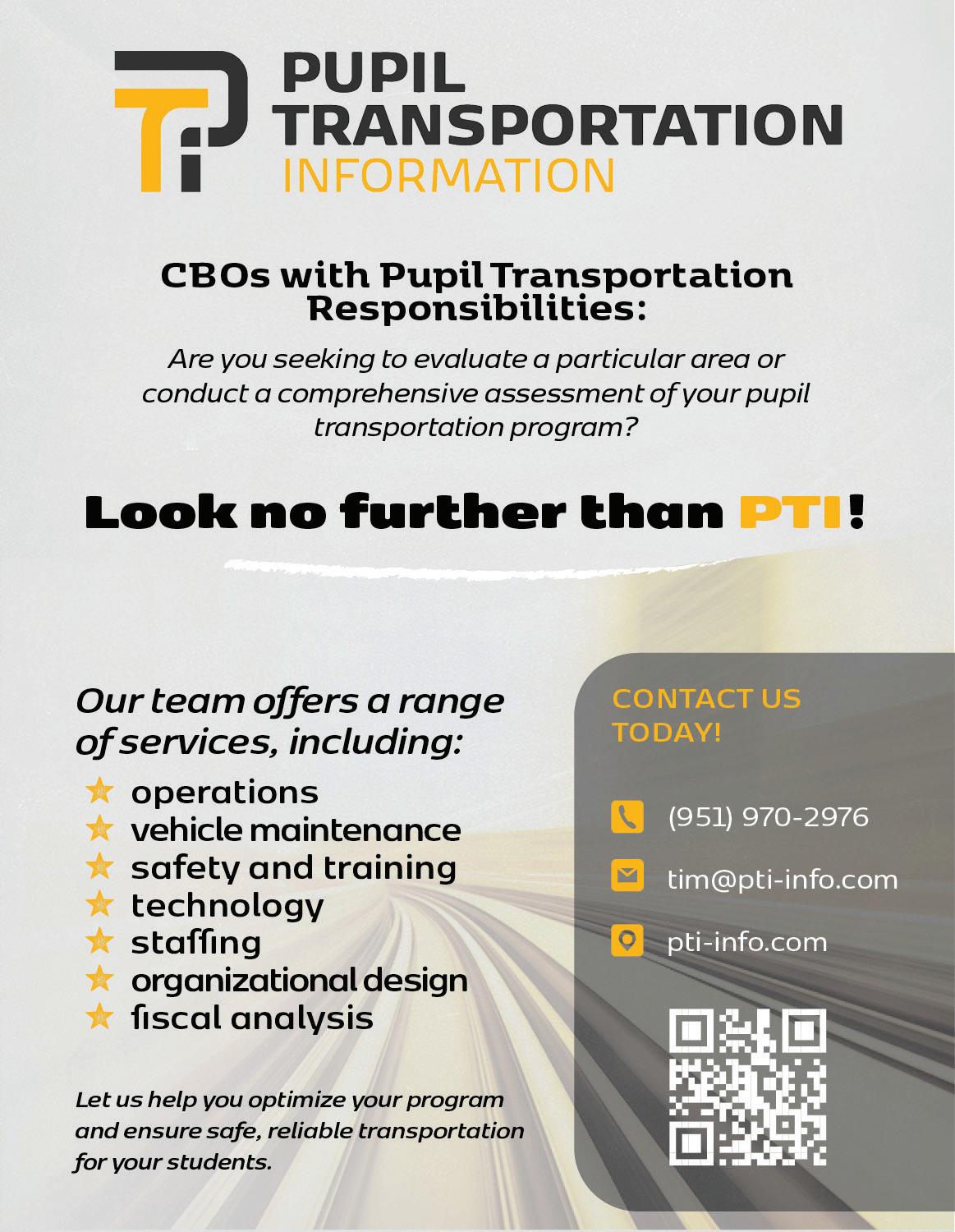

Looking for ways to Prepare for a Tight Budget Year?
A PARS early retirement incentive, known as the Supplementary Retirement Plan (SRP), could create budget savings for your school district in FY '24-'25 and beyond. A properly crafted SRP can help your district proactively address budget and workforce challenges, including:
• Declining enrollment
• Need for workforce and organizational restructuring
• Impending fiscal cliff
PARS offers a no-cost analysis to determine if offering an incentive makes fiscal and operational sense for your district now or in the future.
In addition to a SRP, other solutions that can help your district plan for the future are the PARS/CSBA OPEB Solutions Program and the PARS Pension Rate Stabilization Program (PRSP) to prefund OPEB (retiree healthcare) and pension obligations.
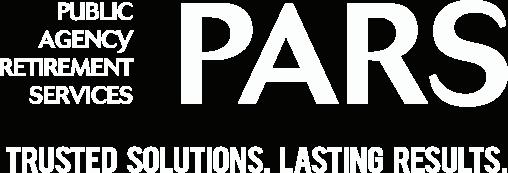
California School Business casbo.org 61 AD INDEX
(800) 540-6369 x127 info@pars.org www.pars.org Amazon Business . . . . . . . . . . . . . . . 38 American Fidelity . . . . . . . . . . . . . . . 3 Blach Construction . . . . Inside Front Cover Brightly Software . . . . . . . . . . . . . . . 45 California Schools VEBA . . . . . . . . . . . 58 California’s Valued Trust . . . . . . . . . . . 4 Capitol Advisors Group LLC . . . . . . . . . 60 Carahsoft Technology Corp. . . . . . . . . . 49 CDW-Government LLC . . . . . . . . . . . . 46 Christy White, Inc. . . . . . . . . . . . . . . . 48 Climatec . . . . . . . . . . . . . . . . . . . . 19 COLBI . . . . . . . . . . . . . . . . . . . . . . 22 Dale Scott & Co. . . . . . . . . . . . . . . . . 58 Dannis Woliver Kelley . . . . . . . . . . . . 46 EdFiles . . . . . . . . . . . . . . . . . . . . . . 55 EH&A/MGT . . . . . . . . . . . . . . . . . . . 22 ENGIE . . . . . . . . . . . . . . . . . . . . . . 27 Equitable . . . . . . . . . . . . . . . . . . . . 49 Fagen Friedman & Fullfrost LLP . . . . . . . 37 Frontline . . . . . . . . . . . . . . . . . . . . 24 Horace Mann . . . . . . . . . . . . . . . . . 21 Kasdan Turner Thomson Booth LLP . . . . 39 Keenan . . . . . . . . . . . . . . . . . . . . . 10 KeyAnalytics, a division California Financial Services . . . . . . . . 24 Lozano Smith . . . . . . . . . . . . . . . . . 57 MeTEOR Education . . . . . . . . . . . . . . 62 ODP Business Solutions . . . . . . . . . . . 21 PEPPM . . . . . . . . . . . . . . . . . . . . . 63
Sandler . . . . . . . . . . . . . . . . . 15 Planetbids, Inc. . . . . . . . . . . . . . . . . 7
Transportation Information . . . 61 Public Agency Retirement Services (PARS) . . . . . . . . . 61 Raymond James . . . . . . . . . . . . . . . 26 Regional Liability Excess Fund / ReLiEF . . . . . . . . . . . . . 62 Schneider Electric . . . . . . . . . . . . . . 60 School Services of California, Inc. . . . . . 55 School Status - School Innovations & Achievement . . . . . . . . . . . . . . . . 27 Schools Excess Liability Fund (SELF) . . . 26 SchoolsFirst Plan Administration . . . . . . 8 Sehi Computer Products, Inc. . . . . . . . . 39 Self-Insured Schools of California (SISC) . . . . . . . . . . . . . . 17 SiteLogicQ . . . . . . . . . . . . . . . . . . . 38 Southwest School & Office Supply . . . . 48 Stifel, Nicolaus & Company . . . Back Cover TIPS . . . . . . . . . . . . . . . . . . . . . . 56 Virco . . . . . . . . . . . . . . . . . . . . . . 31
Piper
PTI-Pupil




62 California School Business Spring 2024 meteoreducation.com Untitled-2 1 2/26/21 7:05 PM ReLiEF Regional Liability Excess Fund

California School Business casbo.org 63

FINANCING CALIFORNIA’S FUTURE
Stifel is the leading underwriter of California K-12 school district bonds.* We assist local districts in providing financing for facility projects and cash flow borrowing, including new construction, modernization, renovation, and technology improvements. Our work with California school districts includes:
■ General Obligation Bonds
■ Mello-Roos Bonds
■ Certificates of Participation/Leases
■ Short-Term Notes and TRANs
■ Refinancing or Restructuring of Previously Issued Bonds
We give back to the communities we serve by providing college scholarships to graduating high school seniors through Stifel’s annual Fabric of Society essay competition and by supporting school-related foundations and functions with charitable contributions.
* Source: Refinitiv, Ranked No. 1 in California K-12 bonds by par amount and number of issues year-to-date as of September 30, 2023.
Stifel, Nicolaus & Company, Incorporated
Member SIPC & NYSE | www.stifel.com
64 California School Business Spring 2024
Let us help you achieve your financing goals. Visit www.stifel.com/publicfinance or contact a member of our School Finance Group:
Kerns Managing Director
Gonzalez Managing Director
Vega Managing Director
vegaf@stifel.com
Vincent Managing Director
443-5006
Barna Managing Director
443-5205
California | Los Angeles Office
California | San Francisco Office
Jin Vice President
Vice President
Bruce
(415) 364-6839 bkerns@stifel.com Erica
(415) 364-6841 egonzalez@stifel.com Frank
(213) 443-5077 |
Dawn
(213)
dvincent@stifel.com Robert
(213)
rbarna@stifel.com Southern
Northern
Esther
(415) 364-6861 jine@stifel.com Emily Bartolotta
(415) 364-6879 bartolottae@stifel.com
















































 Photography by Radical Candor
Photography by Radical Candor
























































 The foremost authority in school business
The foremost authority in school business













